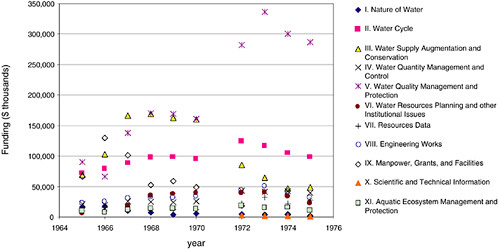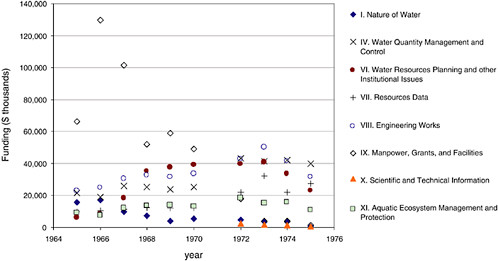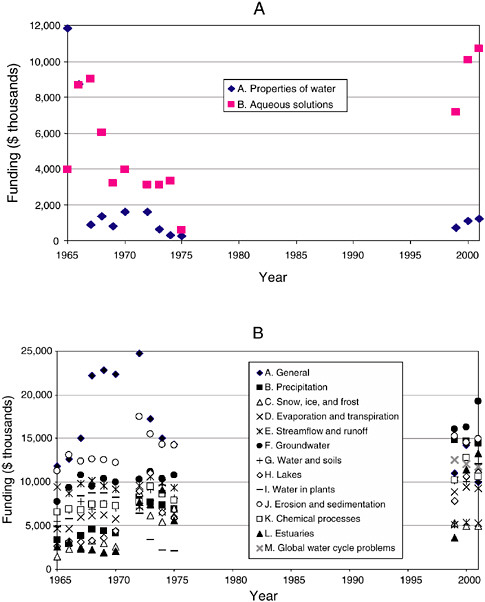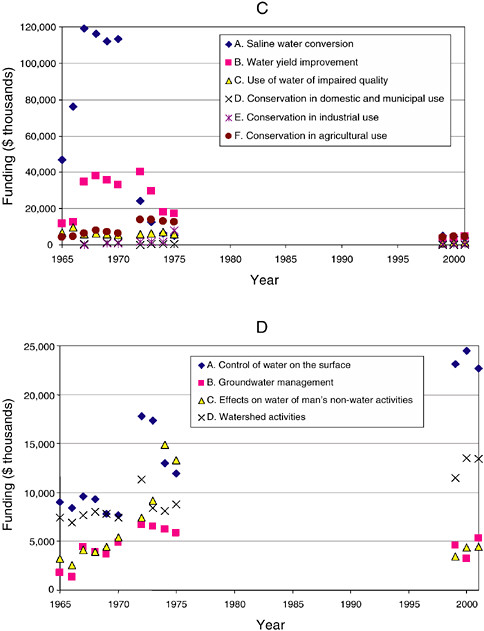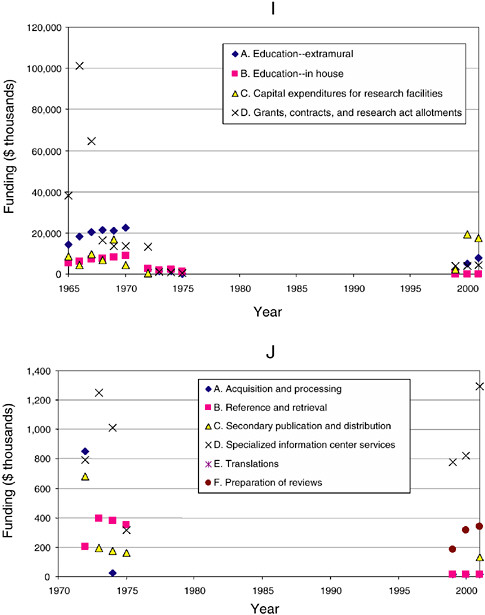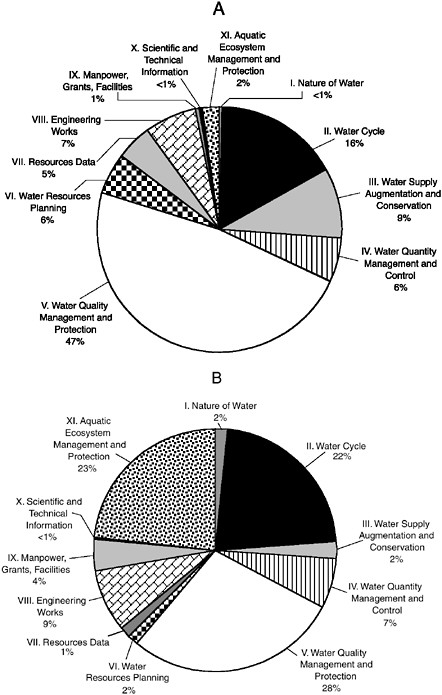4
Status and Evaluation of Water Resources Research in the United States
Establishing a baseline of current research is vital to the task of evaluating whether and how new priorities in water resources research are being addressed. Research is a cumulative enterprise. By necessity, most new research directions will build on existing research infrastructure; other research directions may be established through new research consortia, laboratories, and field sites. Whatever the case, budget initiatives will be cast in terms of departures from the status quo. Unfortunately, the categorization and accounting of water resources research is surprisingly difficult to do under current budgetary procedures. Agencies are not required to report their research to the Office of Management and Budget (OMB) in standard topical or thematic categories. Further, agencies do not report all their research to OMB. For this reason, the committee gathered budget1 and other data, in the form of a survey, from both federal agencies and nonfederal organizations that fund water resources research. This chapter presents the resulting data and the committee’s analysis of those data, as well as conclusions about the scope of the current investment. The conclusions relate directly to those water resources research priorities expressed in Chapter 3 and in NRC (2001) as being paramount to confronting water problems that will emerge in the next 10–15 years.
SURVEY OF WATER RESOURCES RESEARCH
A necessary part of this study involved collecting budget information from federal agencies and significant nonfederal organizations regarding their recent
expenditures on water resources research. Several methods could potentially be utilized to gather and evaluate such budget information. Ultimately, the committee decided to rely on a format used for over ten years in the late 1960s and early 1970s.
Beginning in 1965, the Committee on Water Resources Research (COWRR) of the Federal Council for Science and Technology (FCST), administered out of what was then the President’s Office of Science and Technology, began a yearly accounting of all water resources research conducted by the major federal agencies.2 Budget information, supplied by liaisons from relevant federal agencies, was compiled into ten major categories3 and up to 60 comprehensive subcategories of water resources research. The accounting occurred annually from 1965 to 1975 (except for 1971). The primary goal of COWRR was to facilitate coordination of the various federal research efforts, because it was recognized at that time that water resources research was spread widely throughout the federal enterprise (as it is today). It was also a goal of COWRR to ensure that there was no unnecessary duplication of research efforts, that research was appropriately responsive to current water problems, and that federal resources were available to help solve these problems (COWRR, 1973 and 1974). Nonfederal organizations were not included in the reports.
To compare the current budget information with expenditures on water resources research between 1965 and 1975, the committee adopted the FCCSET model of creating a survey for federal agency liaisons to respond to. The present survey includes most of the same categories and subcategories of water resources research as before, and it encompasses the same waterbodies: fresh, estuarine, and coastal. In January 2003, the survey was submitted to all of the federal agencies that either perform or fund water resources research and to several nonfederal organizations that had annual expenditures of at least $3 million during one of the fiscal years covered by the survey.
The survey consisted of five questions related to water resources research (see Box 4-1). As part of question 1, the liaisons were asked to report total expenditures on research in fiscal years 1999, 2000, and 2001, in order to allow a comparison to the FCCSET survey data of the past. The remaining four questions were posed to help give the committee a better understanding of current and projected future activities of the agencies, and to obtain a qualitative understanding of how research performance is measured. Unlike the data submitted in response to question #1, the answers to the latter questions in the survey are not evaluated in this report in a quantitative fashion.
Responses to the survey were submitted in written form and orally at the third meeting of the NRC committee, held April 29–May 1, 2003, in Washington,
|
BOX 4-1 1a. Please provide budget information for the 11 FCCSET categories for FY1999, FY2000, and FY2001 (as total expenditures, not appropriated funding). A detailed description of each category is attached. b. Please provide an accompanying short (2–3 pages at most) narrative, saying how your programs that encompass water resources research fall into the different FCCSET categories. c. What percentage of these budget numbers were reported to OMB as R&D? (We recognize that there are differences between the OMB definition of R&D and the 11 FCCSET categories.) d. Does your agency conduct research that does not fall into one of the FCCSET categories, but that is considered (by the agency) to be water resources research? Please describe. 2. In no more than 2 pages, provide a summary of your agency’s current strategic plan that governs water resources research. Please include data collection activities. 3. What is being done to coordinate water resources research (1) within your agency, (2) with other agencies, or (3) with external partners (such as the states)? 4. Do you measure progress (i.e., the impact of) in your agency’s water resources research activities? If so, how? (For example, by counting the number of publications, some other metric, etc.) 5. Irrespective of your agency’s mission, what do you think the nation’s water research priorities ought to be?
|
D.C. At that meeting, questions were asked of the liaisons in addition to those listed in Box 4-1 that speak to the different ways that research is conceptualized and conducted within the federal enterprise. These included questions about (1) how the budget information was gathered and the liaison’s confidence in its accuracy, (2) whether the water resources research included in the survey response was conducted internally or externally, and (3) the typical time frame for water resources research within an agency. (Definitions of research relevant to these questions are provided in Box 3-1.) Revised survey responses submitted by the liaisons in June and July 2003 reflected corrections and responses to specific requests from the committee.
The survey requested budget information in 11 major categories (and 71 subcategories) of water resources research. All categories, which are described in detail in Appendix A, closely correspond to categories used in the old FCCSET reports. Nonetheless, some minor changes were made to the old FCCSET categories in order to capture lines of research that were not recognized during the 1960s. Most importantly, new subcategories were added in the areas of global water cycle problems, effects of waterborne pollution on human health, risk perception and communication, other poorly represented social sciences, infrastructure repair and rehabilitation, restoration engineering, and facility protection/ national security. One of the old FCCSET subcategories (VI-C on the ecological impact of water development) was removed from Category VI and was expanded into a new major category (XI) that includes four subcategories on ecosystem and habitat conservation, aquatic ecosystem assessment, effects of climate change, and biogeochemical cycles. This was done in recognition of the increased attention being paid to the water needs of aquatic ecosystems over the last 25 years and a corresponding surge in research in this field. The modified FCCSET categories thus comprehensively describe all areas of research in water resources. It should be noted that the act of data collection, although of paramount importance to water management, is not captured by any of the modified FCCSET categories (Category VII covers research that informs data collection, not data collection itself). This omission on the part of COWRR was intentional, allowing research activities and their budgets to be evaluated independently of monitoring activities. The current survey abides by this separation; that is, the agency liaisons made sure that none of the budget information presented includes pure data collection (e.g., stream gaging, satellite operation, etc.) Nonetheless, given the importance of data collection activities to the water resources research enterprise, Chapter 5 notes recent trends in funding for such activities.
There are obviously limitations inherent in conducting a survey of this nature and in the corresponding results. First and foremost is that the information represents to some degree the best professional judgment of those liaisons that responded. In almost all cases, federal agency programs in water resources research are not organized along the modified FCCSET categories. Undoubtedly, there were cases where a program logically fell into more than one category. In
such cases, the liaisons were asked to give their best judgment of the most relevant category. In addition, variable sources of information were used by the liaisons (in terms of personnel and databases consulted), and the liaisons may have interpreted the survey differently from one another. These factors are reflected by a certain degree of error in the individual budget numbers submitted by the liaisons. However, after questioning the liaisons about their confidence in the submitted information, the committee feels that the magnitude of this error is small when compared to the broad trends that are discerned by the analysis below. Furthermore, the trend analysis is accompanied by a quantitative assessment of uncertainty, which was taken into account during the committee’s evaluation of the data.
Second, the possibility exists that the committee did not capture all of the relevant federal and nonfederal organizations involved in water resources research, either because these organizations were not approached by the committee or because they chose not to participate. With respect to the federal agencies, the committee is confident that all of the major agencies funding or conducting water resources research within the United States were contacted and that the submitted survey responses represent the vast majority of the federal investment in water resources research. There is less certainty about the nonfederal organizations. The major not-for-profit organizations involved in water resources research were contacted, as well as the largest (in terms of funding) of the state Water Resources Research Institutes (in order to reflect state funds spent on relevant research). Nonetheless, it is recognized later in this chapter that the accounting of significant nonfederal organizations’ funding of water resources research may be an underestimate, both in terms of total dollars and represented subcategories.
A related issue for those federal agencies that responded to the survey is that not all of their relevant research funds were reported, especially where certain programs are not characterized as research in their congressional authorization. For example, the Department of Energy’s (DOE) site characterization work in the Yucca Mountain Program (see Chapter 3) is at the cutting edge of hydrogeology, but it is not classified as research for budgetary purposes. [In contrast, the U.S. Geological Survey (USGS) does classify its Yucca Mountain work as research.] Because the agencies would be reluctant to report these types of expenditures, it was not possible for the committee to assess their magnitude or importance. This is also a concern for agencies that conduct extensive place-based studies, most of which are managed separately from the general water resources research program, are not reported to OMB as research, and thus are difficult to account for. Examples include the Florida Everglades restoration—jointly run by the U.S. Army Corps of Engineers (Corps), the Department of the Interior, and the South Florida Water Management District—and CALFED, which is a San Francisco Bay Delta restoration program involving multiple federal and state agencies. For those federal agencies that were identified at the April 2003 committee meeting as funding substantial place-based research, the committee requested that their two largest projects be included in their final response to the survey. These inclu-
sions are reflected in revised survey responses from the Corps and the U.S. Bureau of Reclamation. Nonetheless, not all place-based research from these two agencies could be captured, and no place-based information was collected from other agencies. The U.S. Environmental Protection Agency (EPA) is the other major federal agency thought to have an investment in place-based research. This may also lead to an underestimate in the reported water resources research funding.
Third, the survey covers only fiscal years 1999, 2000, and 2001. Three years of data were felt to be of sufficient quantity to allow the committee to assess the nation’s investment without creating a burdensome task for the liaisons. In addition, vastly differing economic climates prevailed during these years, which may be reflected in the survey responses and may thus enable the committee to observe short-term variability in research expenditures. Clearly, however, these three years of data represent only a snapshot in time. Thus, although there is a trends analysis in this chapter, no assumptions should be made regarding funds spent between 1975 and 1999.4 The current request for information did not cover FY2002 or FY2003 because it was felt that at the time the survey was submitted, the agencies would not be able to provide accurate estimates of total expenditures for those years. Thus, events subsequent to FY2001 that may have impacted research spending (e.g., increased attention to national security) are not reflected in the survey.
Finally, the varying scope of the modified FCCSET categories must be acknowledged. In an attempt to keep the number of subcategories reasonable, some of them broadly lump together what may be, in academic circles, disparate research issues. For example, there is only a single subcategory (VI-H) to capture all water resources research conducted in areas of sociology, anthropology, geography, political science, and psychology. Other subcategories are much more narrowly focused. This diversity, to a certain extent, reflects the fact that some subcategories have a stronger historical linkage to water resources research per se. In general, in those areas where the majority of funds are being spent, the committee tried to maintain or create a larger number of subcategories so that specific trends in funding could be discerned.
For the purposes of the discussion below, the budget numbers from all years were converted into FY2000 constant dollars prior to graph preparation and data analysis.
OLD FCCSET DATA
From 1965 until 1975, data on water resources research funds were collected from the following federal agencies: U.S. Departments of Agriculture, Commerce,
Defense, the Interior, and Transportation; EPA (from 1973 on); the National Science Foundation (NSF); the National Aeronautics and Space Administration (NASA) (from 1966 on); and other smaller agencies such as the Tennessee Valley Authority, Housing and Urban Development, the Atomic Energy Commission, and the Smithsonian Institute. The budget data are presented in a series of annual reports from COWRR and are summarized in COWRR (1973 & 1974). FCCSET data show a steady increase in funding for water resources research between 1964 and 1967, a leveling off from 1967 to 1973, and a slight decrease from 1973 to 1975 (see Figure 4-1). A more in-depth examination reveals that the vast majority of these funds were spent in a few FCCSET categories, and these disparities increased during the examined period. Thus, for example, in 1965, Categories II (water cycle), III (water supply augmentation and conservation), and V (water quality management and protection) constituted over 60 percent of all water resources research, while in 1975, these same categories comprised 76 percent of the total. As shown in Figure 4-2, this increase is attributable to a large increase in spending on water quality management and protection (Category V).
The only FCCSET category that showed positive growth during this ten-year period was V (water quality management and protection), and even this category began to decline after 1973. Most of the other major categories showed relatively stagnant funding during the period, including II (water cycle), IV (water quantity management and control), VII (resources data), X (scientific and technical infor-
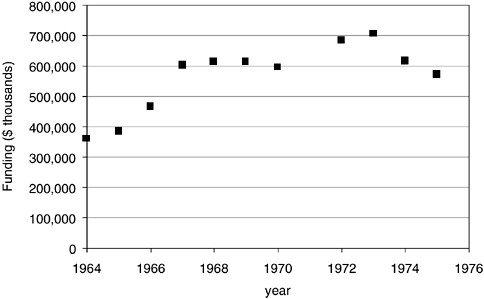
FIGURE 4-1 Total expenditures on water resources research, 1964–1975. Values reported are constant FY2000 dollars. SOURCES: COWRR (1973 & 1974).
mation), and XI (aquatic ecosystem management and protection). Consistently negative trends in funding were observed for Categories I (the nature of water) and IX (manpower, grants, and facilities). For Categories III (water supply augmentation and conservation), VI (water resources planning), and VIII (engineering works), an initial increase observed in the late 1960s was followed by a substantial decrease in the early 1970s, in the case of Category III to levels below the 1965 level (primarily because of a drop in funding for desalination research). Trends for the “smaller” major categories, which are difficult to discern in Figure 4-2, are presented in Figure 4-3.
The reasons for the observed trends likely include an initial interest on the part of Congress and various administrations to increase research spending in the late 1950s and early 1960s, followed by a retraction in the wake of better understanding environmental processes and the resulting competition between environmental water needs and economic growth. As discussed in Chapter 2, the early 1970s saw the federal government transform from an ardent supporter of water resources projects to the primary regulator of industries responsible for declines in water quality. This may also account for the disproportionate support for water quality research (Category V) compared to other areas of research. That is, greater investment in Category V was seen as essential to meeting various water quality standards in the nation’s lakes and rivers, as mandated by the newly minted Clean Water and Safe Drinking Water Acts. Furthermore, in many states, impairment in water quality loomed as a more important constraint on the development of water resources than the issue of supply. In addition, throughout the 1970s, media reports focused on water quality issues, giving them the political prominence that has helped to drive the distribution of research funding shown in Figure 4-2. The topically skewed nature of water resources research in the middle 1970s has been noted in other studies, in particular a FCCSET report that recommended reducing the relative proportion of funding going to Category V, while also calling for overall increases in the total water resources research budget (COWRR, 1977).
WATER RESOURCES RESEARCH FROM 1965 TO 2001
To observe trends in water resources research funding, the FCCSET accounting of 1965–1975 was repeated by requesting budget information from 19 federal agencies known to support water resources research. Table 4-1 lists the federal agencies queried during the first survey period and during this study. A similar request was made of several nonfederal organizations, of which the following were deemed to be making significant contributions to water resources research over the period in question (FY1999–FY2001): the American Water Works Association Research Foundation (AWWARF), the Water Environment Research Foundation (WERF), the Nature Conservancy (TNC), and the four largest Water Resources Research Institutes (Nevada, Pennsylvania, Texas, and Utah). For both
TABLE 4-1 Federal Agency Participation in Surveys on Water Resources Research Funding
|
Agency |
Initial FCCSET period (1965–1975) |
Current Survey (FY1999–FY2001) |
|
Agriculture |
||
|
ARS |
Yes |
Yes |
|
CSREES |
Yes |
Yes |
|
ERS |
Yes |
Yes |
|
FS |
Yes |
Yes |
|
Commerce |
||
|
NOAA (many programs) |
Yes |
Yes |
|
Defense |
||
|
Corps |
Yes |
Yes |
|
ONR |
No |
Yes |
|
SERDP/ESTCP |
No |
Yes |
|
Energy |
No |
Yes |
|
Health and Human Services |
No |
|
|
ATSDR |
|
Yes |
|
NCI |
|
Yes |
|
NIEHS |
|
Yes |
|
Interior |
||
|
USGS |
Yes |
Yes |
|
USBR |
Yes |
Yes |
|
FWS |
Yes |
No |
|
OWRR |
Yes |
No longer in existence |
|
Transportation |
Yes (1966–1971) |
No |
|
FHA |
Yes (1973–1975) |
|
|
Coast Guard |
Yes (1973–1975) |
|
|
EPA |
Yes (1973–1975) |
Yes |
|
NASA |
Yes |
Yes |
|
NSF |
Yes |
Yes |
|
AECa |
Yes |
No longer in existence |
|
TVA |
Yes |
No |
|
Smithsonian |
Yes (1968–1975) |
No |
|
HUD |
Yes (1967–1975) |
No |
|
aThe functions of the Atomic Energy Commission were subsumed by the Nuclear Regulatory Commission via the Energy Reorganization Act of 1974 and by DOE. Note: The National Park Service, U.S. Fish and Wildlife Service, and the Tennessee Valley Authority were contacted but chose not to participate in the current survey. |
||
the federal agencies and the nonfederal organizations, the budget information submitted was total expenditures (and not appropriated funds). In addition, all third-party funding was excluded from the budget numbers, as was funding for pure data collection, education, and extension activities. For the federal agencies, almost all of the funds included in the survey are reported to OMB as research and development funds. Survey data from both federal and nonfederal agencies are summarized and presented graphically throughout the chapter, with detailed information available in Appendix B.
Total Federal Agency Support of Water Resources Research
The total federal funding for water resources research from 1964 to 1975 and for 1999, 2000, and 2001 is shown in Figure 4-4. Annual expenditures on water resources research have remained static near the $700 million mark since 1973, after having doubled between 1964 and 1973. A quantitative analysis was conducted to discern whether there is a significant difference in total funding between the average 1973–1975 levels and the average 1999–2001 levels. In order to do this analysis (which is explained in detail in Appendix C), it was assumed that the annual data contain measurement errors that are independent from year to year, that the distribution of errors in averages of annual values can be well approximated by a normal distribution, that the standard deviation of the errors in averages of annual values ranges in all cases from 25 percent to 50 percent of the

FIGURE 4-4 Total expenditures on water resources research by federal agencies, 1964–2001. Values reported are constant FY2000 dollars.
average, and that there are no significant systematic biases in the annual funding data. As shown in Table 4-2, there is small likelihood that the averages for these two time periods are different under the conditions of uncertainty stated above. This supports the statement that funding levels for water resources research have not changed significantly since the early 1970s.
Figure 4-5 shows how the $700 million was distributed among the federal agencies in FY2000. Notably, no agency contributed more than 25 percent of the total funding, with five agencies (USDA, USGS, NSF, DoD, and EPA) accounting for nearly 88 percent of the total funding. The smaller five agencies (DHHS, USBR, NOAA, DOE, and NASA) together contributed 12.3 percent of the reported total. This speaks to the broad impact of, and interest in, water-related issues across the federal government. Funding trends from 1965 to 2001 for the 11 major categories and their subcategories are shown in Figures 4-6 and 4-7,
TABLE 4-2 Likelihood of a Significant Increase or Decrease in Funding from the 1973–1975 Time Period to the 1999–2001 Time Period (see Appendix C for methods)
|
FCCSET Category |
Likelihood at the 25 percent uncertainty level (%) |
Likelihood at the 50 percent uncertainty level (%) |
Increase or Decrease* |
|
I. Nature of Water |
99.9 |
92.6 |
Large increase |
|
II. Water Cycle |
79.3 |
66.1 |
Increase |
|
III. Water Supply Augmentation |
0.2 |
7.5 |
Large decrease |
|
IV. Water Quantity |
59.3 |
55.1 |
No change |
|
V. Water Quality |
12.0 |
28.0 |
Large decrease |
|
VI. Water Resources Planning |
0.2 |
7.5 |
Large decrease |
|
VII. Resources Data |
0.5 |
9.8 |
Large decrease |
|
VIII. Engineering Works |
66.6 |
57.9 |
Slight Increase |
|
IX. Manpower, Grants, Facilities |
100.0 |
95.0 |
Large increase |
|
X. Scientific and Technical Info |
45.2 |
46.8 |
Slight decrease |
|
XI. Aquatic Ecosystems |
100.0 |
96.7 |
Large increase |
|
Total Water Resources Research |
55.1 |
52.5 |
No change |
|
Total Water Resources Research minus Category XI |
28.5 |
38.9 |
Decrease |
|
*Values above 50 indicate a significant increase from the mid 1970s to the late 1990s. Values less than 50 indicate a significant decrease. Values around 50 percent indicate no significant increase or decrease. |
|||
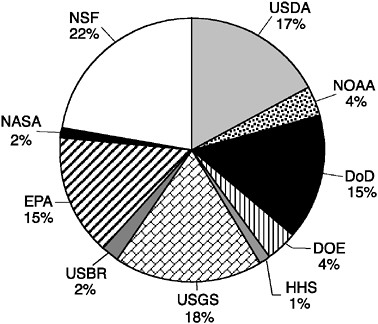
FIGURE 4-5 Federal agency contributions as a percentage of the total funding for water resources research in 2000.
respectively. Note that all three years of data (1999, 2000, and 2001) were used in the trends analysis to follow. However, for the purposes of presentation, the pie charts in this chapter show only data from 2000 (which is generally representative of data from 1999 and 2001).
Several conclusions can be drawn from these graphs. With respect to the trends over time for the individual major categories, most funding levels have remained stable or have declined since the mid 1970s—a conclusion supported by the comprehensive uncertainty analysis presented in Table 4-2 and in Appendix C. Category V (water quality), in particular, declined from 1975 to 2000 both in real terms (from $286 million to $192 million) and as a percentage of total funding (from 50 percent to 28 percent). For this category, it can be stated with high confidence that the mid 1970s funding is higher than the late 1990s funding. Even more dramatic declines are observed for Category III (water supply augmentation), which declined from a high of $64 million in 1973 to $14 million in 2000; Category VI (water resources planning and institutional issues), which declined from a high of $41 million in 1973 to $9.8 million in 2000; and Category VII (resources data), which declined from a high of $32 million in 1973 to $8.7 million in 2000. In these three cases, there is very high likelihood that the mid 1970s
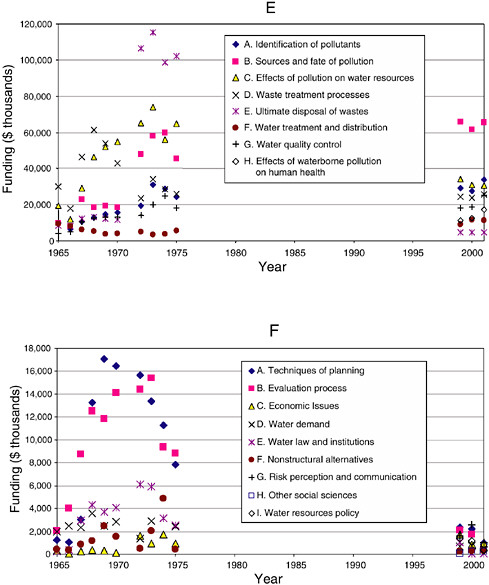
FIGURE 4-7 (E) and (F) Federal agency funding in FCCSET subcategories of Categories V (water quality management and protection) and VI (water resources planning and other institutional issues), 1965–2001. Subcategories V-H, VI-G, VI-H, and VI-I are new to the recent survey. Values reported are constant FY2000 dollars.
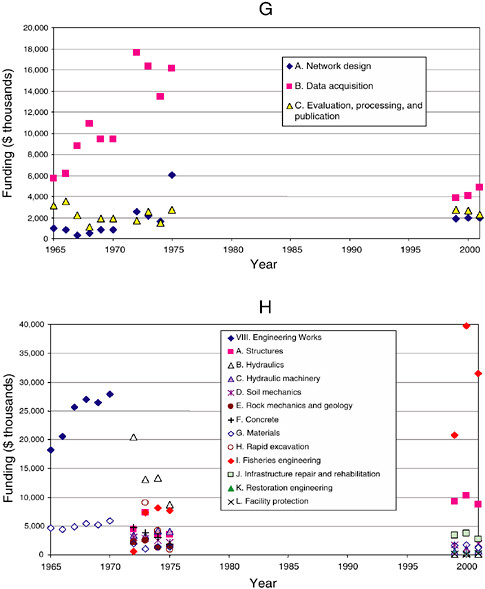
FIGURE 4-7 (G) and (H) Federal agency funding in FCCSET subcategories of Categories VII (resources data) and VIII (engineering works), 1965–2001. Subcategories VIII-B through VIII-I (except VIII-G) were created in 1972 to further define “engineering works.” Subcategories VIII-J, -K, and -L are new to the recent survey. Values reported are constant FY2000 dollars.
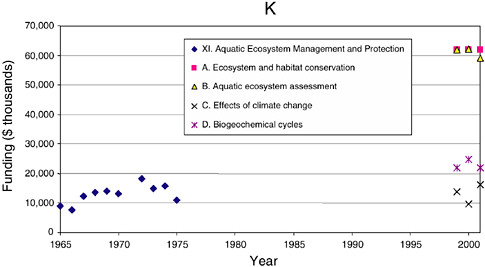
FIGURE 4-7 (K) Federal agency funding in the FCCSET subcategories of Category XI (aquatic ecosystem management and protection), 1965–2001. Note that the four subcategories were created for the recent survey. All relevant research in these four areas was previously recorded in one subcategory (denoted by the black diamond). Values reported are constant FY2000 dollars.
level funding is higher than the late 1990s level, for both cases of uncertainty depicted (that is, where uncertainty is either 25 percent or 50 percent of the mean values). Thus, funding has declined substantially in the late 1990s with respect to the mid 1970s for these four major categories.
Funding in five of the major categories (I—nature of water, IV—water quantity, VIII—engineering works, IX—manpower and grants, X—scientific and technical information) appears from the figures above to be more or less comparable to that recorded 30 years ago. However, when looking quantitatively at the difference between the 1973–1975 and 1999–2001 time periods, some minor trends emerge. In the case of Categories I and IX, there have been significant increases from the mid 1970s to the present. For Category X, one can state with high confidence that funding has decreased since the mid 1970s. And for Categories IV and VIII, there are no significant differences between the funding levels of the two time periods, particularly when it is assumed that uncertainty is equal in value to 50 percent of the mean.
There have been very modest increases in funding for Category II (water cycle) over the entire 30-year period, and the uncertainty analysis in Appendix C supports a high likelihood for an increase in funding from the mid 1970s to the present. However, it is in Category XI where the greatest increases are observed.
Funding for aquatic ecosystem management and protection jumped from $15 million in 1973 to $158 million in 2000 (23 percent of the total water resources research funding that year). This partly reflects the lack of a well-defined category for aquatic ecosystem research during the time of the 1965–1975 FCCSET survey. More important, however, is that concern for aquatic ecosystem management and protection grew enormously following the transformative events that sparked the landmark environmental legislation of the 1960s and 1970s including the Clean Water Act, the Endangered Species Act, and the Wild and Scenic Rivers Act (see Chapter 2). Several decades later, biological diversity and ecosystem processes of lakes, wetlands, and rivers are increasingly at risk, raising concerns for potential degradation of ecosystem goods and services and loss of species. While many of these problems have a long history, most prior research focused on a narrow view of water quality for human use and direct harm to sensitive species. As a consequence of the recent recognition for the need for whole ecosystem research, including studies of long duration and large spatial scale, research expenditures in Category XI have increased greatly. The four distinct subcategories of research into the protection and management of aquatic ecosystems constitute a suite of research activities that were largely absent from the nation’s water resources research or were thought of more in the context of water quality research in the 1960s.
It is interesting to note that the trends for the individual subcategories do not always mirror the trend of their major category. For example, although funding for water quality studies (V) declined overall from the mid 1970s to the present, two subcategories within Category V saw modest funding increases—the identification of pollutants (V-A) and understanding the sources and fate of pollutants (V-B).
As far as balance among the 11 major categories, the situation in 2000 has shifted to encompass far more aquatic ecosystems research than in 1973 (see Figure 4-8). Much of this has come at the expense of funding for Categories III (water supply) and V (water quality). In general, however, there is greater parity among the major categories of water resources research in 2000 than there was in 1973.
Federal Agency Budget Breakdown
A complementary way of presenting the data is to consider how individual federal agencies distributed their expenditures among the 11 major modified FCCSET categories. Although many of the individual offices that reported conducting and funding water resources research from 1965 to 1975 have changed (see Table 4-1), most of the cabinet-level federal agencies involved in supporting water resources research in the mid 1960s are still major players in this enterprise today.
Individual agencies have distinct missions and responsibilities, and they differ in their mandated emphasis on fundamental vs. applied research. These
agencies’ total budgets and the distribution of their research funding exhibit considerable differences as well. In addition to considering the specific distribution of funding by agency and category, the following section briefly reviews the research focus of each agency. (Although the agencies are listed alphabetically in Tables 4-1, 4-3, and 4-4, the following narratives are ordered by the size of the agencies’ funding for water resources research.)
National Science Foundation
Since its inception in 1950, the NSF has awarded grants and contracts that support and strengthen science and engineering research and education, and it plays a significant role in supporting the research infrastructure of the nation’s universities, including support of equipment, student fellowships, individual researchers, and multidisciplinary research teams. Although both basic and applied research efforts are included, the NSF has long been considered a primary, if not the primary, agency supporting curiosity-driven research at academic institutions and nonprofit organizations to address fundamental issues. Although much of the benefit to society of this research is expected to accrue over long periods, some benefits occur in a short time frame.
Water-related research is found in nearly all NSF organizational units as well as in crosscutting initiatives such as the Water and Carbon Cycle initiatives, but there is no single program for water resources research. Research supported by the Directorate for Biological Sciences is relevant to the categories of aquatic ecosystems (XI) and the water cycle (II), and it encompasses a network of Long-Term Ecological Research sites (some of which have an aquatic component). The Directorate for Engineering supports research into water and wastewater treatment; the fate, transport, and modeling of contaminants; and sensors and sensor networks for water quality measurement. The Directorate of Geosciences supports traditional hydrologic science, hydrologic–ecological interactions, and meteorological and climate studies related to the water cycle ranging from precipitation processes to long-term trends in water characteristics. The Directorate for Mathematical and Physical Sciences funds water-related research in chemistry and mathematics, including fundamental properties of water and ice, fate and transport of chemicals in water, and mathematical modeling of the water cycle. The Directorate for Social, Behavioral, and Economic Sciences funds a variety of projects that explore fundamental social, economic, cultural, geographic, or decision-related aspects of human activity related to water resources and facilitates international research linkages and experiences for students and investigators. The Office of Polar Programs supports research on aquatic ecosystems in Arctic regions and Antarctica. The Directorate for Education and Human Resources provides funding for water-related education projects across the full range of directorate programs. Support areas include teacher preparation, curriculum development, informal education projects, and digital library resources. NSF also

FIGURE 4-9 National Science Foundation FY2000 expenditures by major category ($150,892,000 total). Dollar values reported are constant FY2000 dollars.
supports Science and Technology Centers to address water purification, water resources management in semiarid climates, and river processes.
In FY2000, NSF accounted for 22 percent of total federal water resources research expenditures, four-fifths of which was allocated to categories XI (aquatic ecosystems), II (water cycle), and V (water quality), as shown in Figure 4-9. These results are expected, since these categories deal more with fundamental water processes than with water-related operations, data collection, or administration. In addition, NSF has focused its water resources research on the natural rather than the social sciences, accounting for the low percentage of funds spent in category VI (water resources planning and other institutional issues).
U.S. Geological Survey
Created in 1879, the USGS has evolved from being an agency that performs “surveys” of the nation’s land, mineral, and water resources to one that encompasses a broader view of earth science. Its current mission is to provide reliable
scientific information to describe and understand the earth; minimize loss of life and property from natural disasters; manage water, biological, energy, and mineral resources; and enhance and protect our quality of life (USGS, 2002). The USGS today is organized into four major disciplines. The Biological Resources Discipline—added to the USGS in 1995—focuses on status and trends of natural systems, basic ecological understanding, analysis of threats, and application of knowledge to management and stewardship. In the past, the Geology Discipline has focused on fundamental geological processes, hazard assessment, and energy and minerals. Its portfolio today includes water-related topics, including the environmental impacts of climate variability, the geological framework for ecosystem structure and function, and geological controls on groundwater resources and hazardous waste isolation. The Geography Discipline is responsible for building, maintaining, and applying The National Map. The discipline leads in partnerships with state and local governments and the private sector in producing state-of-the-art geographic tools and products, such as topographic, geological, and hydrographic maps of the entire nation.
The mission of the Water Resources Discipline (WRD) is to “provide reliable, impartial, timely information that is needed to understand the Nation’s water resources” (USGS, 2004). As such, USGS scientists conduct research on a wide array of issues central to human and environmental health, including drinking water quantity and quality, impacts of population growth, urbanization and other land-use changes, suitability of aquatic habitat for biota, hydrologic hazards, climate, surface water and groundwater interactions, and hydrologic system management. The WRD maintains a long-term data collection program to collect, manage, and provide scientifically based information that describes the quantity and quality of waters in the nation’s streams, lakes, reservoirs, and aquifers. Prime examples include the network of stream gages, the National Stream Quality Accounting Network (NASQAN) program, the Hydrologic Benchmark Network program, and the groundwater-level network. Communication of data and information is a priority of all USGS disciplines. Data collected by the USGS as part of its monitoring activities are widely used by a variety of agencies responsible for water and environmental management and by businesses, citizens, and researchers in government, academia, and the private sector. Trends in funding for data collection per se are discussed in Chapter 5.
With one programmatic exception, all water-related research is conducted in-house by USGS scientists. USGS has several types of programs for conducting research: a centrally coordinated National Research Program in the hydrologic sciences; distributed research investigations, including district offices, the National Water Quality Laboratory Methods Group, portions of the National Water Quality Assessment Program (NAWQA), the Yucca Mountain Project, and the Cascades Volcano Observatory; and programs that are primarily focused on the geology or biology disciplines. About 25 percent of USGS funding for water-related research is managed through the National Research Program. The
USGS manages one external water research program, which is the state Water Resources Research Institutes.
USGS, which contributed 18 percent of the total research budget in FY2000, distributed 80 percent of those funds primarily in Categories XI (aquatic ecosystem management and protection), II (water cycle), and V (water quality management and protection) (see Figure 4-10). Within those three categories, funds were distributed evenly among most subcategories. Aquatic ecosystems research is a growing area of emphasis and is conducted within the Biological Resources and Water Resources disciplines. USGS research supports federal resource management needs in the Everglades, the San Francisco Bay-Delta, the Snake and Columbia river systems, and other systems. Fundamental research on the water cycle and water quality is led by the Water Resources Discipline. The Survey’s research on the water cycle has provided a critical foundation for domestic and international hydrologic and energy balance studies related to regional water management and flood control, as well as for understanding the longer-term implications of climate change. Research on all aspects of water

FIGURE 4-10 U.S. Geological Survey FY2000 expenditures by major category ($123,108,000 total). Dollar values reported are constant FY2000 dollars.
quality is driven by priorities and problems identified by state and local partners, the NAWQA program (initiated in 1991), and programs related to toxic chemical and aquatic ecosystem function. Category IX (manpower, grants, facilities) accounted for 15 percent of USGS expenditures, the majority of which supported water research facility infrastructure such as the Hydrologic Instrumentation Facility. Some of these funds, authorized by the Water Resources Research Act of 1965 as amended, provide for research, education, and information exchange with the 54 state Water Resources Research Institutes. In addition, a small part of that program ($1 million) supports a competitive grants program at academic institutions to address high-priority water issues.
U.S. Department of Agriculture
The USDA supports water-related research with four major agencies. The Agricultural Research Service (ARS) is the principal in-house research agency for USDA and contributes around two-thirds of the USDA funding for water resources research. Its research agenda is organized under 22 national programs, one of which is Water Quality and Management, which supports three main programs relevant to the nation’s agricultural water resources. The first of these three programs, agricultural watershed management, includes research on water supply and use on irrigated and rain-fed lands to optimize water use and resolve competing demands through establishment of science-based technologies and management. Irrigation and drainage management research, the second program, is intended to support efficiency and sustainability in the face of anticipated declines in water availability. Third, water quality protection and management research emphasizes reducing water contamination from agricultural lands. ARS research is conducted at nine research centers and 83 research locations situated throughout the nation. The missions of several of the research locations including the USDA Water Conservation Lab in Phoenix, Arizona, and the USDA Salinity Lab at Riverside, California, address water and water-related topics. Although most of its research is done by USDA scientists (some of whom hold faculty positions), ARS further involves university faculty in research projects through partnerships and cooperative agreements. Although much of the ARS research is applied (to agricultural problems), there is also a significant component of basic research.
The Cooperative State Research Education and Extension Service (CSREES) provides about 20 percent of the USDA’s funding for water resources research. Its primary functions are to identify, develop, and manage programs to support university-based and other institutional research, education, and extension in order to advance knowledge for agriculture, the environment, human health and well-being, and communities. The majority of research functions of CSREES are carried out by faculty at the nation’s land grant colleges and universities. In addition to providing core research support for these faculty, CSREES operates a number of annual, extramural research competitions that pertain to the effects of
agricultural practices on aquatic ecosystems and watersheds, including nonpoint source nutrients and other contaminants. CSREES activities fall into three program areas: (1) the National Research Initiative, (2) the Hatch Act, and (3) the 406 National Integrated Water Quality Program. Most of the research focuses on water and watershed issues as they relate to agriculture and the conservation of agricultural resources.
The U.S. Forest Service (USFS) has contributed about 18 percent of the USDA funding for water resources research in recent years. It maintains an inhouse staff of researchers, including forest hydrologists, fisheries scientists, aquatic ecologists, and climate researchers, to support its management of 155 national forests and 20 national grasslands and to provide outreach to managers of state and private lands. Research units are organized into eight regional research stations, and many of the scientists at the research stations hold academic appointments at nearby universities. USFS scientists cooperate extensively with colleagues from universities and other agencies engaged in forestry and related research and in integrated studies such as the six Long-Term Ecological Research studies that are focused on USFS experimental watersheds. Thus, the research programs of the USFS are closely integrated with and related to the programs of research carried out by faculties at the schools and colleges of forestry. The USFS maintains a broad disciplinary orientation among its research staff, including hydrology, fisheries, aquatic ecology, climatology, engineering, and economics. Research focuses include watershed management, aquatic–terrestrial interactions, fisheries, water quality, and ecology. There are extensive programs of research on watershed management that address issues related to water yields and the maintenance of water quality from forest and range lands. Although much of the USFS research is applied research directed to problems of managing forests and grasslands, the USFS also devotes a substantial effort to investigate basic, long-term questions.
The Economic Research Service (ERS) provides economic analysis relevant to support a competitive agricultural system as well as promote harmony between agriculture and the environment. The general areas of research include the economics and policy dimensions related to agriculture, food, natural resources, and rural development. In the water domain, the agency provides survey-based information on irrigation and water use for agriculture. The ERS economic research program informs USDA policy and program decisions affecting water quality and wetland preservation, and it also derives economic implications of proposed or alternative water quality regulations for the food, agricultural, and rural sectors. The research activities of ERS also address institutional issues such as those related to water transfers and water markets and institutional responses to drought and water scarcity. All of this research is conducted by an internal staff of economists and social scientists, because this agency makes few extramural grants outside of its food, nutrition, and invasive species management program areas. This is the only federal agency having an interest in water research that focuses exclu-
sively on economic and institutional issues, and it constitutes less than 1 percent of the USDA funding total for water resources research.
In FY2000, these agencies within USDA accounted for 17 percent of total federal water resources research expenditures. Research into the water cycle (II), mainly under ARS, accounts for one-third of USDA water-related research, and this research appears to be distributed across multiple aspects of the water cycle in an agricultural context. Water quality management and protection (V), supported by ARS and CSREES, is the next-largest category and includes research aimed at water quality control, pollutant source and fate, and waste disposal. All of the agencies with the exception of ERS support research on water quantity management and control (IV), due to the importance of agriculture in influencing runoff and other watershed processes. Aquatic ecosystem research (XI) at USDA derives almost exclusively from the fisheries research done by the USFS. Water supply augmentation and conservation (III) supported by ARS includes research primarily into water yield improvement and agricultural water use conservation. Together these five categories make up virtually all USDA water-related research expenditures, as shown in Figure 4-11.
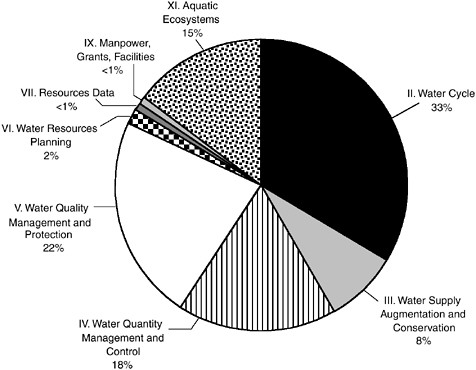
FIGURE 4-11 Department of Agriculture FY2000 expenditures by major category ($116,126,000 total). Dollar values reported are constant FY2000 dollars.
U.S. Department of Defense
About 80 percent of Department of Defense (DoD) funding for water resources research is contributed by the Corps, with lesser amounts coming from the Office of Naval Research (ONR) (about 2 percent) and the Strategic Environmental Research and Development and Environmental Security Technology Certification Programs (SERDP/ESTCP) (about 18 percent). Programmatic areas for the Corps include navigation systems, flood and coastal protection, environmental technologies, infrastructure engineering, geospatial technologies, and integrated technologies for decision making. The mission of the Corps is largely operational in nature, and thus most of the research is highly applied. Its regulatory responsibilities are generally limited to specific provisions of the Clean Water Act, particularly with respect to managing and regulating wetlands. Engineering works, hydraulic modeling, soil mechanics, and contaminated dredge materials are some major research focuses, with the majority of Corps activity being based at seven research laboratories around the nation. In-house research is conducted at seven research laboratories (Coastal and Hydraulics Laboratory, Geotechnical and Structures Laboratory, Information Technology Laboratory, and Environmental Laboratory, all in Vicksburg, MS; Cold Regions Research and Engineering Laboratory, Hanover, NH; Construction Engineering Research Laboratory, Champaign, IL; Topographic Engineering Center, Alexandria, VA) or at the Institute for Water Resources at Fort Belvoir, VA, and its Hydrologic Engineering Center at Davis, CA.
ONR coordinates, executes, and promotes the science and technology programs of the U.S. Navy and Marine Corps through grants to schools, universities, government laboratories, and nonprofit and for-profit organizations. It provides technical advice to the Chief of Naval Operations and the Secretary of the Navy and works with industry to improve technology manufacturing processes. SERDP/ ESTCP carries out research to reduce costs and environmental risks by developing cleanup, compliance, conservation, and pollution prevention technologies. In addition, SERDP/ESTCP funds research on cleanup of contaminated defense sites, DoD compliance with environmental laws and regulations, and measures to reduce defense waste streams.
DoD activities account for 15 percent of the overall federal total for water resources research. As shown in Figure 4-12, about half of DoD funds are spent in Category VIII (engineering works), which is anticipated to be necessary to support the Corps’ large operational mission, and about a fourth of the funds are spent in Category V (water quality management and protection), which is where almost all SERDP/ESTCP and ONR funds are devoted.
U.S. Environmental Protection Agency
As mentioned in Chapter 2, the EPA was created in 1970 to carry out broad responsibilities for both regulation and research, with an emphasis on protecting
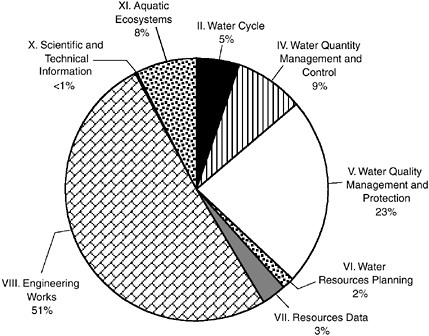
FIGURE 4-12 Department of Defense FY2000 expenditures by major category ($104,668,000 total). Dollar values reported are constant FY2000 dollars.
human and environmental health by protecting our land, air, and water. EPA’s Office of Research and Development (ORD) carries out diverse water-related research activities that focus principally on water quality, including microbial pathogens and chemical contaminants and their impact on drinking water and ecosystems; human and ecological health and risk assessment; water quality criteria to support designated uses of fresh waters; tools for assessment, protection, and restoration of impaired aquatic systems; and improved water and wastewater treatment technologies. Water resource-related research is supported primarily through ORD’s network of national laboratories and its grant programs.
ORD has five branches that support research centers and laboratories at 13 locations across the country: the National Center for Environmental Assessment (NCEA), the National Center for Environmental Research (NCER), the National Exposure Research Laboratory (NERL), the National Health and Environmental Effects Research Laboratory (NHEERL), and the National Risk Management Research Laboratory (NRMRL). Through NCER, EPA runs competitions for STAR (Science Targeted to Achieve Results) grants and graduate and undergraduate fellowships, provides research contracts under the Small Business Innovative Research Program, and supports other research assistance programs.
NHEERL oversees a network of researchers and facilities, with headquarters in Research Triangle Park, North Carolina; additional laboratories with activities in freshwater resources include the Western Ecology Division (Corvallis, Oregon), the Mid-Continent Ecology Division (Minnesota and Michigan), the Gulf Ecology Division (Gulf Breeze, Florida), and the Atlantic Ecology Division (Narragansett, Rhode Island). Many components of the research conducted by the branches apply to water issues. NRMRL divisions include the Water Supply and Water Resources Division, as well as the Ground Water and Ecosystem Restoration Division. NERL includes the Microbiological and Chemical Exposure Division. EPA primarily emphasizes research relevant to national priorities for safeguarding the environment, although its STAR programs allow investigators to pursue wideranging fundamental scientific issues with direct relevance to applications.
EPA’s share of total federal water resources research (15 percent in FY2000) is strongly dominated by Categories XI (aquatic ecosystems) and V (water quality), followed by II (water cycle) and IV (water quantity management and control), as shown in Figure 4-13. To a significant extent, research in these categories responds to EPA’s regulatory mandates as dictated under the Safe Drinking Water Act, the Clean Water Act, the Comprehensive Environmental
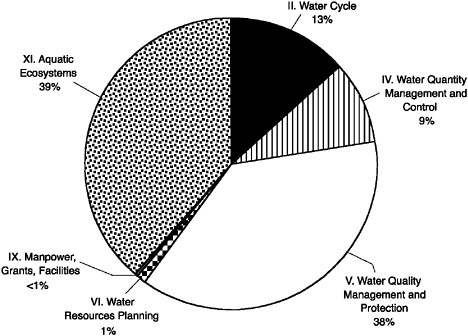
FIGURE 4-13 Environmental Protection Agency FY2000 expenditures by major category ($98,970,000 total). Dollar values reported are constant FY2000 dollars.
Response, Compensation, and Liability Act, and the Resource Conservation and Recovery Act. Funding for water quality management (V), for example, primarily emphasizes water and wastewater treatment and contaminant fate and transport studies.
U.S. Department of Energy
The mission of the DOE is to advance “the national, economic, and energy security of the United States; to promote scientific and technological innovation in support of that mission; and to ensure the environmental cleanup of the national nuclear weapons complex” (DOE, 2003). The nondefense portion of the department is organized into offices specializing in technologies related to specific energy sources such as fossil fuels, nuclear energy, and renewable energy; each office supports applied research in its field. For example, the Office of Fossil Energy has identified three major goals in its water–energy research and development strategy: reduce the use of freshwater resources in fossil energy production and use, improve the quality and reduce the volume of water used in fossil energy production, and reduce water management costs over conventional technology. Its research accounts for around 10 percent of the DOE total for water resources research.
The majority of the DOE funding (about 90 percent) for water resources research comes from the Office of Science, which sponsors studies of the fundamental physical, chemical, and biological processes affecting the fate and transport of contaminants in the subsurface. Much of this research is sponsored by the Environmental Management Science Program, which supports basic research that could enable new, faster, less expensive, and more effective methods for the cleanup of the nuclear weapons complex.
As shown in Figure 4-14, DOE’s 3.8 percent share of total federal water resources research expenditures is almost exclusively in Category V (water quality management and protection)—not unexpected given its responsibility for some of the most complex hazardous waste sites in the nation. Most DOE-funded water research relates to pollutants and waste treatment associated with the cleanup of hazardous chemical and radioactive waste at former nuclear weapons production facilities. Other water quality research is directed at the pollutant streams from fossil fuel energy production, affecting both surface water and groundwater.
Apart from the water-related research that was reported to the committee, extensive studies are carried out in other programs, but these studies are not classified as “research” for various statutory reasons and were not included in the survey response. For example, since 1978, DOE’s Office of Civilian Radioactive Waste Management has spent “billions of dollars on characterization studies,” a significant portion of which was focused on hydrology, climate change, and the fate and transport of radionuclides at the proposed nuclear waste repository site at Yucca Mountain, Nevada (DOE, 2002, p. 33). Similarly, the Office of Environ-
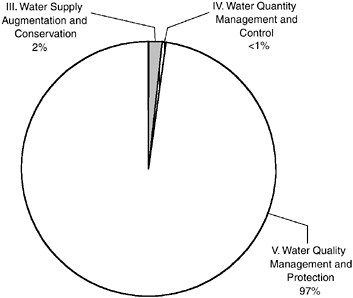
FIGURE 4-14 Department of Energy FY2000 expenditures by major category ($26,053,000 total). Dollar values reported are constant FY2000 dollars.
mental Management has conducted extensive characterization studies of contaminated DOE sites in support of cleanup efforts.
National Oceanic and Atmospheric Administration
Several programs within NOAA (which is within the U.S. Department of Commerce) contribute to water resources research. The National Weather Service (NWS) comprises just less than 10 percent of the reported NOAA total, with the rest split fairly evenly between the National Ocean Service (NOS) and programs within the Office of Oceanic and Atmospheric Research (OOAR). The NOAA water resources research programs have a primarily water cycle and coastal focus, although several other activities concern freshwater resources. (For the purposes of the NOAA survey, “coastal” refers to the land and water area extending from the inland boundary of coastal watersheds to the seaward boundary of the United States Exclusive Economic Zone. In the Great Lakes region, this includes the watersheds of the Great Lakes and St. Lawrence River.) In particular, the NOAA Office of Global Programs (OGP) carries out most of the fundamental research pertaining to the water cycle, to climate predictability and prediction studies and their role in water resources management, and to the social impacts of climate
variability and change. The NWS through the Office of Hydrologic Development, Hydrology Laboratory, carries out applied research relating to hydrologic and hydraulic modeling and forecasting at all spatial scales. The Advanced Hydrologic Prediction Service (AHPS) program of the Office of Hydrologic Development provides new hydrologic information and products through the infusion of new science and technology into the operational forecasting process. The inclusion of the Great Lakes within NOAA’s Great Lakes Environmental Research Laboratory (GLERL) brings NOAA further into areas of freshwater research. NOAA’s coastal research is concerned with agricultural nonpoint source pollution and the resulting hypoxia in coastal waters, as well as other land-based pollutants delivered via runoff. In all the areas, research is conducted both in-house and through grants to external research organizations (universities, nonprofits, and other private sector organizations).
NOAA research accounts for 3.7 percent of the federal total, mainly in Categories II, V, and XI, which focus, respectively, on water cycle processes, water quality management and protection in estuarine and freshwater systems, and aquatic ecosystems (Figure 4-15).

FIGURE 4-15 National Oceanic and Atmospheric Administration FY2000 expenditures by major category ($24,715,000 total). Dollar values reported are constant FY2000 dollars.
U.S. Bureau of Reclamation
The U.S. Bureau of Reclamation (USBR), within the Department of the Interior, is a major supplier of drinking and irrigation water and hydroelectric power. Its mission is confined to the 17 western states. As an operating agency, USBR water resources research is concentrated on applied topics of water development and management. USBR focuses on four main areas: improving water and hydropower infrastructure reliability and efficiency, improving water delivery reliability and efficiency, improving water operations decision support with advanced technologies and models, and enhancing water supply technologies. Examples of research include desalination, river system modeling, fish passage and entrainment, and operational efficiency enhancements.
USBR research accounts for 2 percent of the federal agency total and is distributed across Categories II (water cycle), III (water supply augmentation and conservation), IV (water quantity management and control), V (water quality management and protection), and VIII (engineering works) (see Figure 4-16). Consistent with its mission as a nonregulatory/operating agency, the USBR devotes a large part of its research expenditures to support the operation of water control structures as well as desalination.

FIGURE 4-16 U.S. Bureau of Reclamation FY2000 expenditures by major category ($14,207,000 total). Dollar values reported are constant FY2000 dollars.
National Aeronautics and Space Administration
Historically, NASA has developed satellite missions in broad support of many different problems related to the earth sciences including environmental change, tectonophysics, oceanography, hydrology, and glaciology. Science teams are formed early in the process of mission design and are involved with converting satellite measurements to useful science products. Once useful information becomes available on a routine basis, NASA provides funding to university and other researchers for innovative application toward enhanced understanding of critical earth science questions. As a result, it is difficult to determine the direct financial influence of NASA programs on hydrologic sciences. Only the more recent satellite missions (e.g., Aqua, Terra, TRMM) have had continental hydrologic sciences as a theme. With most other missions (e.g., TOPEX/Poseidon and Jason-1, Landsat, GRACE), the products support a myriad of other science programs in oceanography, environmental change, agriculture, and forestry. Nevertheless, data from these missions are beneficial for hydrologic sciences, especially for large-scale studies. The NASA estimate of the annual support for water resources research (1.5 percent of the federal total) is primarily directed to a better understanding of fundamental water cycle processes (Category II), as illustrated in Figure 4-17. This includes direct research support to investigators addressing specific hydrologic problems. There has been minor support for studies

FIGURE 4-17 National Aeronautics and Space Administration FY2000 expenditures by major category ($10,100,000 total). Dollar values reported are constant FY2000 dollars.
involving water quality. Because the total NASA expenditures in satellite development and in operation and funding of science teams for the various missions are of a magnitude that would dwarf all other research expenditures considered in this report, and because the percentage of those activities devoted to water resources research is impossible to determine, they are not included in the NASA survey response.
Department of Health and Human Services
The Department of Health and Human Services (DHHS) has over 300 research and service programs in 11 operating units, eight of which are in the U.S. Public Health Service (PHS). Two major units of the PHS are the National Institutes of Health (NIH) and the Centers for Disease Control and Prevention (CDC). Both NIH and CDC house water-related research activities, but neither has federally mandated regulatory authority for water-related research or management.
NIH’s environmentally related research is focused in the National Institutes of Environmental Health Science (NIEHS) and the National Cancer Institute (NCI). The mission of NIEHS centers on reducing morbidity linked to environmental causes. The agency supports research, prevention, intervention, and communication programs. NIEHS includes the National Toxicology Program, which conducts toxicological research; examines reproductive, developmental, cancer, and immunotoxicity outcomes; and develops alternative models. NCI conducts and supports research and its application to prevent, control, detect, diagnose, and treat cancers. The intramural research unit contacted to respond to the survey was the Division of Cancer Epidemiology and Genetics’s Occupational and Environmental Epidemiology Branch, which conducts epidemiologic studies to evaluate cancer risks and determines whether they are associated with water contaminants, primarily chemicals. (Thus, the survey does not reflect research conducted or funded by other intramural research programs or extramural grants at the NCI.)
CDC provides health surveillance programs to monitor and prevent disease outbreaks and exposures, conducts research, implements programs and services to prevent disease, and maintains vital statistics and other health databases for the nation. However, CDC neither has funding legislatively directed toward water resources, nor does it have a research program specifically directed toward linking water contaminants and human health outcomes. The agency has recently consolidated with the Agency for Toxic Substances and Disease Registry (ATSDR). ATSDR’s mission is focused on preventing hazardous exposures from waste sites and related adverse health outcomes. The agency accomplishes its mission through the conduct of public health assessments, health studies, surveillance activities, health education services, and toxicological profiles of hazardous chemicals. Two programs account for nearly three-quarters of the agency’s water-related funding—the Research Program on Exposure-Dose Reconstruction (EDRP) and the Great Lakes Human Health Effects Research Program (GLHHERP). The
EDRP conducts applied research to reconstruct past and model potential levels of contaminants in environmental media and water distribution systems from the source to the receptor populations. The GLHHERP is focused on the 11 critical contaminants identified by the International Joint Commission (United States and Canada). The program characterizes exposures to these contaminants; identifies at-risk populations; investigates the potential for acute and chronic adverse health outcomes; and conducts community-based research, education, and interventions.
The total water resources research funding from DHHS in FY2000 was $9.13 million, all in Category V-H (effects of waterborne pollution on human health), and thus, no figure of the DHHS breakdown is provided. During the three years of the survey period, the NIEHS contribution ranged from 48 percent to 68 percent of the DHHS total, the ATSDR contribution ranged from 18 percent to 51 percent, and the NCI contribution ranged from 1 percent to 14 percent.
Budget Breakdown by Major Modified FCCSET Category
A final level of analysis involves considering which agencies supported the 11 major modified FCCSET categories. Of the 11 major categories, multiple agencies play significant roles in six, while the remaining five are largely within the domain of a single agency. While the data were not reported in terms of the continuum from basic to applied research, nor from the standpoint of external grants vs. in-house agency research, some inferences can be drawn from the liaison reports, the stated agency missions, and the experience of committee members.
As shown in Figure 4-18, research into the nature of water (Category I) is funded primarily by NSF, with a small percentage from the USGS. Most of this funding is expected to support basic research in universities and other research organizations.
Research into the water cycle (II) is the third-largest funding category and is well distributed across the federal agencies (as shown in Figure 4-19). NSF, USDA, and USGS together provide three-quarters of the research funds in this area, but five other agencies, particularly EPA, NOAA, and NASA, also provide research funding. This area likely includes a diversity of subtopics, ranging from fundamental investigations of evapotranspiration and runoff to applied studies in agricultural landscapes. Assuming that the contributions of NSF, as well as some of the funding from USDA and EPA, are through extramural grants, perhaps one-third to one-half of the research occurs at universities and research institutions, and the remainder is conducted by federal agency scientists.
Research into water supply augmentation and conservation (Category III) is largely through the USDA, although USBR contributes about one-third of the total via desalination work (see Figure 4-20).
As shown in Figure 4-21, nearly half of the research into water quantity management and control (IV) is through the USDA, although the EPA and DoD each contribute about 20 percent of the total. This distribution is expected, given
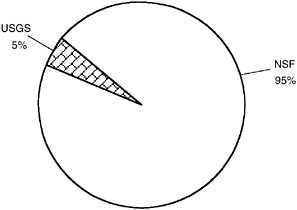
FIGURE 4-18 FY2000 expenditures in Category I (nature of water) by federal agency ($11,153,000 total). Dollar values reported are constant FY2000 dollars.

FIGURE 4-19 FY2000 expenditures in Category II (water cycle) by federal agency ($150,835,000 total). Dollar values reported are constant FY2000 dollars.
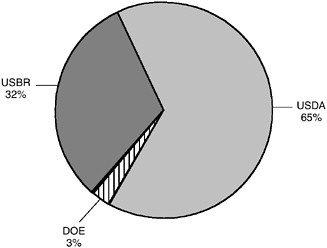
FIGURE 4-20 FY2000 expenditures in Category III (water supply augmentation and conservation) by federal agency ($14,456,000 total). Dollar values reported are constant FY2000 dollars.
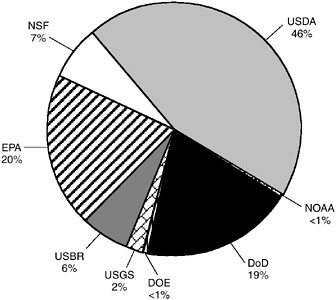
FIGURE 4-21 FY2000 expenditures in Category IV (water quantity management and control) by federal agency ($45,629,000 total). Dollar values reported are constant FY2000 dollars.
the importance of controlling polluted runoff from agricultural lands within USDA and given EPA’s interest in understanding the impact of different land uses on surface water and groundwater flow rates. This research activity is presumed to include a mix of agency science, contracts, and external grants.
Research into water quality management and protection (Category V) is the largest single funding category and is arguably the most widely distributed across agencies. Six agencies (EPA, NSF, DoD, USGS, USDA, and DOE) each contribute 13 percent to 19 percent of the total, and three others report 1 percent to 5 percent contributions (see Figure 4-22). All of the water resources research reported by the DHHS falls under the subcategory of understanding the effects of waterborne pollution on human health. However, most of the contributions of the other agencies are widely spread among the eight subcategories. Much of this work likely falls in some intermediate region between basic and applied research, although most of it is likely to be motivated by application. The fraction that takes place in universities and research organizations may exceed one-third, assuming that USDA and EPA each make substantial grants in this area, in addition to NSF.
As shown in Figure 4-23, NSF is the largest single supporter of research into water resource planning (Category VI), followed by USDA and DoD. This cat-
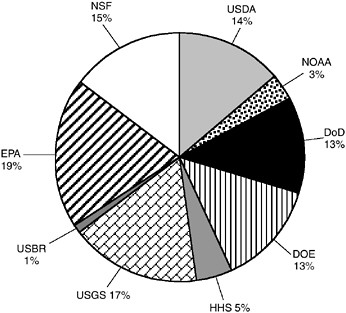
FIGURE 4-22 FY2000 expenditures in Category V (water quality management and protection) by federal agency ($191,669,000 total). Dollar values reported are constant FY2000 dollars.
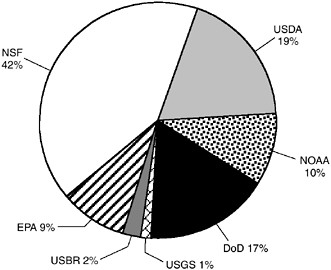
FIGURE 4-23 FY2000 expenditures in Category VI (water resources planning and other institutional issues) by federal agency ($9,834,000 total). Dollar values reported are constant FY2000 dollars.
egory was interpreted to include academic research into decision-related aspects of human activity and other social sciences within NSF, management and planning in an agricultural context within USDA, and integrated technologies for decision making within the Corps. It is likely that somewhat over half of the research occurs in academic or research institutions, and much is intermediate on the continuum of fundamental vs. applied research.
Over half of the research in water resources data (Category VII) is supported by DoD and USGS, although most of the surveyed agencies play a role (Figure 4-24). Research into data acquisition, storage, standards and delivery, modeling, and information technologies are especially prominent topics for the two agencies leading in this area, which serve such diverse needs as integrated assessment modeling, network design, and interagency collaboration. The majority of this research is presumed to be motivated by near-term application needs and to take place within the federal agencies. It is noted again that this category does not encompass expenditures on actual data collection (see Chapter 5 for a more comprehensive discussion of data collection).
Research into water engineering works (Category VIII) is almost exclusively the province of the Corps (and thus DoD) (see Figure 4-25). This is research of a highly applied and practical nature to support the Corps’ Civil Works program and presumably is carried out by Corps scientists and engineers and through contracts.
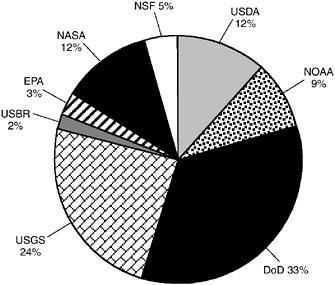
FIGURE 4-24 FY2000 expenditures in Category VII (resources data) by federal agency ($8,679,000 total). Dollar values reported are constant FY2000 dollars.

FIGURE 4-25 FY2000 expenditures in Category VIII (engineering works) by federal agency ($58,118,000 total). Dollar values reported are constant FY2000 dollars.
As shown in Figure 4-26, research supporting Category IX (manpower, grants, and facilities) is largely through the USGS, followed by NSF. These expenditures by USGS support facilities. Within NSF, these funds support water-related education projects across the directorates and research facilities.
Support for research into Category X (scientific and technical information) is almost entirely from NSF (Figure 4-27).
Category XI, aquatic ecosystems, is the second-largest individual funding category and includes significant support from NSF, EPA, USGS, and USDA (Figure 4-28). This category was not present in the original FCCSET categories but was developed to reflect emerging research interests since the 1960s in the areas of ecosystem and habitat conservation, ecosystem assessment, climate change, and biogeochemical cycles. NSF supported research in all four subcategories but allocated less to climate change than the other three subcategories, which it supported roughly equally. EPA funding was entirely for aquatic ecosystem assessment. USGS supported primarily the ecosystem conservation and assessment categories. The USDA funding, primarily from USFS, supports watershed and fish habitat research. If funding support by a number of federal agencies is a measure of importance, only Category V enjoys funding as diverse as that of Category XI (compare Figures 4-22 and 4-28). The funding for aquatic ecosystems protection and management appears to support a healthy balance of agency and external researchers and a range of fundamental to applied research.
Nonbudgetary Survey Information
As mentioned earlier, the survey included questions about the federal agencies’ missions with respect to water resources (see Box 4-1, question 2), as well as questions about the liaisons’ concern irrespective of their agencies’ missions (question 5). Although it is not possible to quantify the liaisons’ responses to these questions, it is useful to examine the similarities between what the agencies’ stated missions are and what the liaisons believe are important emerging water resources issues. The results, presented in Table 4-3, show that few liaisons expressed future issues of concern (column 3) that would not fit into their own agency’s research agenda. Furthermore, it is clear that the current agency missions (column 2) do not add up to a national research agenda for water resources.
In terms of emerging issues (column 3 of Table 4-3), there are several commonalities among the agencies’ responses. The importance of extreme events and the effects of global climate change; the fate, transport, and effects of pollutants; the nature and control of nonpoint source pollution; and the maintenance and restoration of aquatic ecosystems are issues that emerged from more than one liaison response and are also priorities for this committee, as reflected in Table 3-1. Each of these is a complex, multifaceted problem that reflects many scientific, economic, and societal factors; thus, the overlap is not surprising. However, most agency liaisons phrased their perception of these large-scale issues in terms of
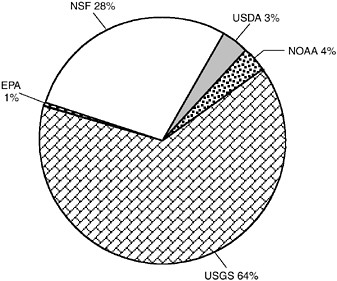
FIGURE 4-26 FY2000 expenditures in Category IX (manpower, grants, and facilities) by federal agency ($27,994,000 total). Dollar values reported are constant FY2000 dollars.
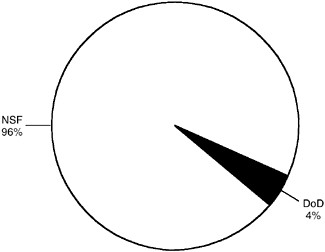
FIGURE 4-27 FY2000 expenditures in Category X (scientific and technical information) by federal agency ($1,168,000 total). Dollar values reported are constant FY2000 dollars.

FIGURE 4-28 FY2000 expenditures in Category XI (aquatic ecosystem management and protection) by federal agency ($158,436,000 total). Dollar values reported are constant FY2000 dollars.
their particular missions, which tend to vary widely depending on whether water is the primary focus of the agency mission (e.g., water resources division of USGS) or is a necessary ingredient for some other purpose (e.g., production of food or energy). Thus, it is unlikely that the overlap in the identification of emerging issues is reflected in coordination of research among agencies.
Several additional questions asked of the federal agency and nonfederal organization liaisons during the third committee meeting related to (1) whether the agency’s research is conducted extramurally or internally, (2) the time horizon of the research, and (3) whether there are significant place-based studies that are not captured in the submitted budget data. The first question partly reflects whether the research is agency mission-driven or investigator-driven, because research conducted externally is likely to be less constrained by the agency’s mission. The time horizon refers to whether the research is expected to have short-term or long-term benefits, which can sometimes be correlated with whether the research is basic or applied (as discussed in Box 3-1). Responses to these questions are summarized in Table 4-4. (It should be noted that not all the agencies responded to these questions, particularly those agencies that submitted their surveys after May 2003.)
TABLE 4-3 Summary of Federal Agency Responses About Their Strategic Plan and Future Water Resources Research Priorities
|
Agency |
Responses to Survey Question 2—Mission |
|
Agriculture |
|
|
USDA ARS |
Program 201: to develop innovative concepts for determining the movement of water and its associated constituents in agricultural landscapes and watersheds, and to develop new and improved practices, technologies, and strategies to manage the nations’ agricultural water resources. Three components: agricultural watershed management, irrigation and drainage, and water quality protection and management. |
|
USDA CSREES |
Strategic plan not yet defined, but protection and improvement of water quality and reducing society’s reliance on freshwater resources are among the issues being discussed. |
|
USDA ERS |
To provide accurate and timely information on (1) the interrelationships between agricultural water availability and agricultural production, (2) the impact of programs and policies that reallocate water resources used by agriculture, (3) the impacts of agricultural production on water quality, and (4) impacts that water quality policies have on the agricultural sector. |
|
USDA USFS |
No stated water-specific mission. General USFS mission is to enhance scientific understanding of ecosystems, including human uses, and to support decision making and sustainable management of the nation’s forests—through research, inventory, and monitoring. |
|
Commerce |
|
|
NOAA NOS |
There are 4 facets to the general NOAA mission: (1) protect, restore, and manage coastal and ocean resources through ecosystem-based management, (2) understand climate variability and change, (3) provide weather and water information, and (4) support safe, efficient, and environmentally sound transportation. NOS has responsibilities under each that focus on coastal and estuarine areas. |
|
NOAA NWS |
General NOAA mission given above is applicable. More specific to NWS is increased accuracy and lead time of river and stream forecasts. Specific data the NWS collects in support of its forecasting mission include river, reservoir, precipitation and snow measurements, and precipitation data derived from Geospatial Operational Environmental Satellite (GOES) and NEXRAD. |
|
Responses to Survey Question 5—Emerging Issues |
|
|
|
Agency |
Responses to Survey Question 2—Mission |
|
NOAA OOAR |
Same 4 general NOAA facets, stated above for NOAA NOS. For OOAR in particular, provide research to enable effective management of fisheries, invasive species, and coastal, ocean, and Great Lakes ecosystem health. |
|
Defense |
|
|
Corps |
Civil Works Program Strategic Plan: (1) provide sustainable development and integrated management of the nation’s water resources, (2) repair past environmental degradation and prevent future environmental loss, (3) ensure that operating projects perform in a manner to meet authorized purposes and evolving conditions, (4) reduce vulnerabilities, risks, and losses to the nation and the Army from natural and man-made disasters, including terrorism, and (5) be a world-class public engineering organization. Current emphases of the R&D program include regional sediment management, systems-wide modeling, assessment and restoration technologies, technologies and operational innovations for urban watershed networks, and navigation economic technologies. |
|
SERDP/ESTCP |
SERDP: to resolve environmental concerns in ways that enhance military operations and improve military systems effectiveness, and to support technology and process development in order to reduce operational and life cycle costs associated with environmental cleanup. Examples relate to development of technologies for remediation of groundwater contaminated with heavy metals and development of bioremediation technologies for treatment of nitroaromatic-contaminated soil and groundwater. ESTCP: to demonstrate and validate promising, innovative technologies that target DoD’s urgent environmental needs (e.g., characterization and treatment of range contamination and in situ remediation of groundwater. |
|
ONR |
None with respect to water resources research. |
|
Responses to Survey Question 5—Emerging Issues |
|
|
|
Unanswered |
|
|
|
Unanswered |
|
Agency |
Responses to Survey Question 2—Mission |
|
Energy |
|
|
DOE |
The three major goals of the Fossil Energy water-energy R&D strategy are: (1) reduce the use of freshwater resources throughout the fossil-energy production and use cycle, (2) improve the quality and reduce the volume of water discharged from fossil energy operations, including coal mining, coal bed methane and oil/natural gas production, and thermoelectric power generation, and (3) reduce water management costs over conventional technology. The Office of Science research program has two primary elements relevant to the types of water resources research: (1) developing new characterization and remediation techniques and (2) developing an improved understanding of contaminant fate and transport. |
|
Health and Human Services |
|
|
NIEHS |
National Toxicology Program: rodent and other animal-based research and testing to address potential adverse health outcomes in humans from exposure to waterborne chemical and biological contaminants. |
|
NCI |
To assess cancer risks from waterborne contaminants. |
|
ATSDR |
Research Program on Exposure-Dose Reconstruction goals: to evaluate human health risk from toxic sites and releases and take action in a timely and responsive public health manner. For many site-specific projects: to ascertain the relationship between exposure to toxic substances and disease. |
|
Interior |
|
|
USGS |
The Water Resources Discipline: provide reliable, impartial, timely information needed to understand the nation’s water resources. The National Research Program (NRP): to generate and disseminate knowledge by conducting fundamental and applied research on complex hydrologic problems, to develop techniques and methodology, and to provide scientific leadership in hydrology to the USGS. NRP investigations integrate hydrologic, geological, chemical, climatological, and biological information related to water resources and environmental problems. |
|
Responses to Survey Question 5—Emerging Issues |
|
|
|
Unanswered |
|
|
|
Agency |
Responses to Survey Question 2—Mission |
|
USBR |
Appropriated funds under the Science and Technology Program are focused on four main areas: (1) improving water and hydropower infrastructure reliability and efficiency, (2) improving water delivery reliability and efficiency, (3) improving water operations decision support with advanced technologies and models, and (4) enhancing water supply technologies. |
|
Other Agencies |
|
|
EPA |
Conduct leading-edge, sound scientific research to support the protection of human health through the reduction of human exposure to contaminants in drinking water, in fish and shellfish, and in recreational waters and to support the protection of aquatic ecosystems, specifically, the quality of rivers, lakes, and streams and coastal and ocean waters. Furthermore, apply the best available science (i.e., tools, technologies, and information) to support regulations and decision making for current and future environmental and human health hazards related to exposure to contaminants in drinking water, fish, and shellfish, and recreational waters and for the protection of aquatic ecosystems. |
|
NASA |
No current strategic plan for water resources research. A water management program plan is under development that will explain how NASA science data products can be used by partnering agencies. |
|
NSF |
No formal agency strategic plan for water resources research, although several planning documents address water issues (e.g., Geosciences Beyond 2000, Complex Environmental Systems, Synthesis for Earth, Life and Society in the 21st Century). |
|
Responses to Survey Question 5—Emerging Issues |
|
|
TABLE 4-4 Additional Facts about the Federal Agencies Supporting Water Resources Research
|
Agency |
Internal vs. extramural |
Significant place-based research |
Short-term vs. long-term, basic vs. applied |
|
Agriculture |
|||
|
USDA ARS |
95% internal |
None mentioned |
50% address long-term problems; 50% address short- and midterm problems |
|
USDA CSREES |
100% extramural |
None mentioned |
25% address long-term basic research issues; 75% address short-term applied research issues |
|
USDA ERS |
>99% internal |
None mentioned |
Research projects are designed to inform policy questions that may arise over a midterm time frame |
|
USDA USFS |
>90% internal |
None mentioned |
40% address long-term problems; 60% address short- and midterm problems |
|
Commerce |
|||
|
NOAA NOS |
70–80% awarded via competitive peer review, of which 70–80% goes to the extramural academic community |
None mentioned |
About 70% of the proposed payoff is expected in the 3- to 5-year time frame, with the remaining 30% in the 5- to 10-year time frame |
|
NOAA NWS |
Approximately 20% of NWS OHD’s research funds are for extramural grants (75% of which are extramural research projects via a competitive program) |
None mentioned |
25% is directed, use-inspired research, and 75% is applied research for improved operations |
|
NOAA OOAR |
OGP: 50% spent extramurally; all of the other offices support only internal research |
Not answered |
OGP has a long-term commitment and annually funds 3-year projects; GLERL has a long-term commitment to research; other lab programs are assembled from 3-year projects |
|
Agency |
Internal vs. extramural |
Significant place-based research |
Short-term vs. long-term, basic vs. applied |
|
Defense |
|||
|
Corps |
50-60% internal; 40-50% extramural |
Five large regional projects occurred during the time frame of the survey, of which the largest two were included in the response |
60% is development, 35% is applied research, and 5% is basic research; most projects are composed of multiple short-term focused R&D targets in the 3-year range; the overall program often gets stretched out due to annual funding uncertainties, but the R&D is characteristically short-term in nature |
|
SERDP/ESTCP |
Not answered |
Not answered |
Not answered |
|
ONR |
95% extramural |
None |
100% basic research with most projects lasting 3–6 years |
|
Energy |
|||
|
Office of Science |
100% extramural |
None |
100% intermediate- to long-term basic research. Most projects are funded for 3–5 years at a time, and may be renewed several times |
|
Office of Fossil Energy |
100% extramural |
None |
Short- to intermediate-term applied research |
|
Health and Human Services |
|||
|
NIEHS |
Not answered |
Not answered |
Not answered |
|
NCI |
100% internal |
None mentioned |
The studies range from 3 to 30 years, depending on the need for follow-up; primary role is to conduct scientific investigations that are considered by regulatory agencies when developing policy |
|
ATSDR |
25% internal; 75% extramural |
None mentioned |
ATSDR supports applied research, and most studies are completed in 3–5 years |
|
Agency |
Internal vs. extramural |
Significant place-based research |
Short-term vs. long-term, basic vs. applied |
|
Interior |
|||
|
USGS |
Almost all is internal except for the Water Resources Research Institutes |
None mentioned |
Most of the National Research Program is long-term; about 10% of the rest of the water research done in the water discipline would be classified as long-term |
|
USBR |
66% internal; 33% extramural |
Place-based research may double budget; (two large projects were included in a revised response) |
Most of the research has a short-term and applied focus |
|
Other Agencies |
|||
|
EPA |
3 national labs included in survey response: some extramural money, mainly in-house STAR program: all extramural 2 Centers: internal |
Region-specific projects are not included in the survey response (e.g., Chesapeake Bay program) |
40% of EPA research is problem driven—in particular, that research specifically designed to meet the needs of the water program at EPA |
|
NASA |
25-33% internal; 66–75% extramural |
None mentioned |
According to OMB, 100% of the NASA budget is applied research; there are almost no long-term, in situ projects, although satellites are multiyear projects |
|
NSF |
100% extramural |
None mentioned |
Varies, but much has a long-term focus |
From Table 4-4, it is clear that water resources research is conducted both internally and externally across the federal agencies. However, most agencies (or individual offices within the agencies) support only one or the other. For example, within the USGS, research is conducted in-house, and the majority is based at USGS research centers; other activities are located in USGS district offices and cooperative units at public universities. Many of the researchers in the centers and cooperative units also carry academic appointments. Most USBR research is carried out in-house or as part of multiagency site-based projects. The NSF employs only program staff, such that all research activity is conducted by
awardees outside the agency. The exceptions are (1) the Corps, where research is about 60 percent in-house and about 40 percent through contractual arrangements with universities, consulting firms, etc.; (2) the NOAA Office of Global Programs; and (3) the DOE, which provides both grants to university-based researchers and direct funding of scientists in national laboratories like Lawrence Berkeley, Lawrence Livermore, and Sandia.
Only the USGS National Research Program and the NSF have a predominantly long-term and basic research focus. Almost without exception, the federal agency liaisons discussed their research in the context of their agency mission, and noted that usable results are expected in a short time frame (within five years), although this was not always achieved.
Finally, the issue of place-based research that would not be captured in the current survey was greatest for the Corps, USBR, and EPA; only EPA was unable to provide budget information for its two largest place-based projects.
Nonfederal Organization Support of Water Resources Research
A variety of nonfederal organizations contribute to water resources research, although only the largest and most obvious organizations were contacted for participation in the committee’s survey. WERF provides funding for applied research of importance to its subscribing members, which include utilities and municipalities, environmental engineering and consulting firms, and industrial organizations. Research areas include primarily water quality issues, particularly pollutants, waste treatment, development of the Total Maximum Daily Load process, and various issues related to water quality management and protection. AWWARF coordinates research for a similar set of subscribers and focuses on drinking water quality, infrastructure reliability, efficient customer responsiveness, and environmental leadership. Among environmental nongovernmental organizations, The Nature Conservancy supports water-related research through its Freshwater Initiative, through field office conservation planning, and through fellowships and small grants to researchers at universities and other organizations.
Also included here are summaries of nonfederal research expenditures from four state Water Resources Research Institutes (WRRIs), which together provide a snapshot of expenditures from nonfederal (mainly state) sources. WRRIs are located in each of the 50 states (as well as the District of Columbia, Puerto Rico, the U.S. Virgin Islands, and Guam) generally within the land grant university for that state. In lieu of contacting all of the institutes, the four that have the largest annual funding were asked to show how their nonfederal water resources research dollars are allocated among the modified FCCSET categories. Some of the research supported by states is coordinated with or carried out by the WRRIs, each of which is a federal–state partnership that (1) plans, facilitates, and conducts research to aid the resolution of state and regional water problems, (2) promotes technology transfer and the dissemination and application of research results,
(3) provides for the training of scientists and engineers through their participation in research, and (4) provides for competitive grants to be awarded under the Water Resources Research Act (discussed in Chapter 2). States and their political subdivisions are becoming increasingly involved in supporting research to resolve local/regional issues particularly in the area of aquatic ecosystems restoration and management, with the ongoing Everglades and San Francisco Bay Delta programs being good examples. This research is generally in partnership with one or more federal agencies. Obviously, research funded or conducted by state and local governments but not reported by these four WRRIs (including work done in other states) is not captured in the following analysis. Depending on the state, this research component may be nontrivial, although it is highly unlikely to be of the magnitude of the overall federal investment in water resources research.
Budget data equivalent to that provided by the federal agencies were collected from nonfederal organizations that support water resources research. However, because the responding organizations were not queried during the earlier FCCSET exercise, no trends analysis can be done showing how this contribution has evolved over the last 30 years. As shown in Figure 4-29, the level of funding for water resources research from nonfederal organizations is very small in comparison to that of the federal agencies—about 5.5 percent of the combined federal and nonfederal total in FY2000. This fraction, and the nonfederal spending for individual major categories, was quite stable over the three years covered by the survey.
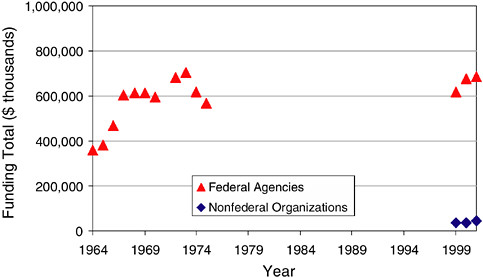
FIGURE 4-29 Expenditures on water resources research, 1964–2001, by federal and nonfederal organizations. Dollar values reported are constant FY2000 dollars.
In terms of which major categories receive the most funds, the nonfederal organizations that were queried mirror the federal agencies in supporting primarily Categories V (water quality) and XI (aquatic ecosystems) (see Figure 4-30), but to an even greater extent. Categories V and XI consume 37 percent and 29 percent of the nonfederal expenditures, respectively, but only 28 percent and 23 percent of the federal expenditures. There are some other interesting differences. The nonfederal organizations provide support for some categories that are clearly lower funding priorities for the federal agencies, notably Categories III (water supply augmentation) and VI (water resources planning and other institutional issues). Alternatively, nonfederal funding for Categories II (water cycle) and IV (water quantity management) is much less, as a percentage of total funding, than the corresponding federal contribution.
The expenditures from WERF, AWWARF, and the four largest WRRIs were substantially different, in terms of the categories of supported research. WERF and AWWARF funds are dominated by water quality (Category V) research (82 percent and 73 percent, respectively), which is not surprising given the stated missions of the organizations (which focus on wastewater and drinking water, respectively) and their constituencies (primarily wastewater and drinking water
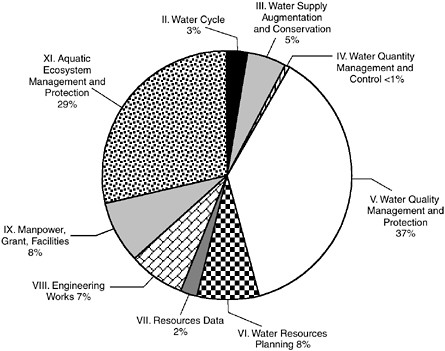
FIGURE 4-30 Percentage of the total expenditures from the queried nonfederal organizations going to each major category for FY2000.
treatment plant operators). All of the research supported by these two organizations is conducted externally by universities, consultants, and other contractors.
The WRRIs, on the other hand, cover the major categories much more uniformly. The Division of Hydrologic Sciences of the Desert Research Institute, University of Nevada, has received around $250,000–400,000 annually for a wide range of projects covering seven of the 11 major categories, with water quality control (Subcategory V-G) being the most funded subcategory. The Pennsylvania Water Resources Research Center and Institutes of Environment reported $5 million to $8 million annually in nonfederal funding for water resources research, although the committee had difficulty distinguishing research expenditures from other expenditures, including staff and infrastructure support. The Texas Water Resources Institute reported nearly $5 million in nonfederal expenditures in 2001, their most complete year of reporting. Water supply augmentation (Category III) and manpower (Category IX) were the dominant categories, and liaison notes indicate these were federal earmarks (although they are unlikely to have been reported by any of the federal agencies). The Utah Water Resources Institute reported annual expenditures of about $5 million, primarily in Categories II, V, VI, VII, and XI.
It is important to note the limitations of the budget data received from the significant nonfederal organizations. As suggested above, the values may have a significant degree of error, if activities other than research were reported or if federal funds were reported. For example, WRRI responsibilities extend to teaching (fellowships) and outreach, not all of which may have been teased out of the reported numbers. Furthermore, as stated earlier it is likely that the total amount of funded water resources research from nonfederal entities is an underestimate, given the small number of participants in the survey (although the survey was sent to all those organizations known to focus on water and to conduct at least $3 million of research annually). In addition, the survey does not reflect very recent trends in topical funding at the nonfederal organizations. For example, since September 11, 2001, there has been a substantial shift in emphasis at AWWARF to fund research related to water security issues. This work was mandated in the 2002 Bioterrorism Act and is being conducted in partnership with EPA. Over $2.35 million is slated for about a dozen water security research projects, each in the $150,000 range, to begin in the 2002–2004 time frame. It is important to keep these limitations in mind when considering both the scope and the magnitude of the nonfederal investment in water resources research.
EVALUATION OF THE CURRENT INVESTMENT IN WATER RESOURCES RESEARCH
Chapter 3 discussed several criteria for evaluating individual research areas for inclusion in the national water resources research agenda, including the national significance of the research, how well research in certain areas has pro-
gressed, and the need to have a balanced portfolio of research topics. In the spirit of those criteria, the following evaluation of the current investment in water resources research considers three primary issues. First, the total funding for water resources research and the trends in that funding over the last 30 years are considered, with comparison to other research areas such as national defense, health, and transportation. Second, the specific topical areas that are currently funded are compared to the research areas discussed in Chapter 3 (Table 3-1) as the highest priorities for the next 10–15 years. Finally, the balance of the current research enterprise is evaluated with respect to several factors mentioned in Chapter 3, including whether the research is short-term or long-term, fundamental or applied, investigator- or mission-driven, and internally or externally conducted.
Overall Funding
The level of federal investment in water resources research has not grown from the early 1970s. Statistically stated, there is low to no likelihood that the 1999–2001 total budget values are higher than the 1973–1975 values. Indeed, when Category XI (aquatic ecosystems) is removed from the survey results, one finds that the federal investment has declined, in constant FY2000 dollars, from a high of $691 million in 1973 to $526 million in 2001—a conclusion supported by the uncertainty analysis presented in Appendix C.
One way to evaluate the current federal investment relative to future needs is to compare the growth rate of water resources research funding to economic and demographic parameters such as population growth, the annual gross domestic product (GDP), the annual federal budget outlay, and federal expenditures on water and wastewater infrastructure. While water resources research funding has remained stagnant in real terms over the last 30 years, population has grown from 212 million in 1973 to 285 million in 2001, a 26 percent increase. Thus, the per capita spending on water resources research has fallen from $3.33 in 1973 to $2.40 in 2001. Similar trends are observed when comparing water resources research funding to GDP and the federal budget. GDP has grown steadily for the last 30 years, more than doubling between 1973 and 2001. During that time, water resources research funding has decreased by over half from 0.0156 percent of the GDP to 0.0068 percent. Outlays from the federal budget have increased from $877.2 billion in 1973 (in FY2000 dollars) to $1.857 trillion in 2001, with the portion of the budget devoted to water resources research shrinking by more than half from 0.08 percent to 0.037 percent. All of these trends are shown in Figure 4-31, which plots the 1973–1975 average data vs. 1999–2001 average data for water resources research per capita and for water resources research as a percentage of GDP and of the budget outlay.
The frequency of conflicts surrounding water resources has increased with population growth, most notably in areas where water demands press hard on available supplies (see the five bolded questions throughout Chapter 1). If one

FIGURE 4-31 Bar graph showing how funding for water resources research (WRR) has decreased between 1973–1975 and 1999–2001. Three parameters are shown: water resources research funding per capita, water resources research as a percentage of GDP, and water resources research as a percentage of the total budget outlay. All dollar values in constant FY2000 dollars. Note the different y-axes. SOURCE: Population data from the U.S. Census, GDP data from the Bureau of Economic Analysis, federal budget outlays from the U.S. Government Printing Office (2003).
assumes, as the evidence in Chapter 1 suggests, that the need for water resources research should roughly parallel population and economic growth and the associated increase in conflicts, then the three trends above suggest that current levels of investment in water resources research are insufficient to address future problems. Research is not all that is falling behind on a per capita and per GDP basis. Federal expenditures on water infrastructure projects (drinking water and wastewater only) over the last decade have been stagnant as well (GAO, 2001), despite increasing calls for repair and replacement of aging systems (e.g., GAO, 2002).
Spending on water resources research can also be compared to spending on other lines of research of national importance. Annual spending for research and development across the federal enterprise is compiled by the American Association for the Advancement of Science (AAAS) for 11 functional categories, as listed in Table 4-5. Because of the broad nature of these categories, this information cannot be used to determine research spending in water disciplines, although water issues can be envisioned to fall under several of these categories, particularly environment, agriculture, and general science. Table 4-5 suggests that the current annual expenditure of about $700 million for water resources research pales in comparison to the annual federal support for defense and health, and it
TABLE 4-5 Major Functional Categories of Federal Government Research and Development (values reported in millions of dollars, adjusted to FY2000 dollars)
|
Category |
FY1999 |
FY2000 |
FY2001 |
|
Defense |
43,499 |
43,160 |
44,925 |
|
Health |
16,983 |
18,758 |
21,134 |
|
Space |
8,819 |
8,437 |
8,704 |
|
General science |
5,521 |
5,593 |
6,177 |
|
Environment |
2,090 |
2,082 |
2,079 |
|
Transportation |
1,852 |
1,664 |
1,608 |
|
Agriculture |
1,483 |
1,561 |
1,776 |
|
Energy |
1,217 |
1,146 |
1,284 |
|
Commerce |
506 |
530 |
455 |
|
International |
196 |
200 |
245 |
|
All other |
698 |
637 |
616 |
|
Total R&D |
82,864 |
83,769 |
89,003 |
|
SOURCES: AAAS (2000, 2001, 2002). |
|||
also lags behind expenditures for transportation, agriculture, and energy research—areas that many might agree are comparable in importance to the provision of clean water. Indeed, the difference in the amount of federal support received by the health and water resources fields in FY2000 suggests that health research is 28 times more important than research on water and wastewater services (including all the services provided by aquatic ecosystems). Furthermore, there is evidence that spending in some these other fields has paralleled population and economic growth, unlike water resources research. Figure 4-32 shows data from AAAS on annual federal expenditures for (A) nondefense research and development and (B) combined defense and nondefense research and development. Data on expenditures for health research show remarkable increases, particularly in the last 10 years. This growth in funding for health research has exceeded population growth, such that per capita spending on health increased from $28 in 1973 to $67 in 2001 (both in FY2003 dollars).
Topical Areas
It is also important to analyze the modified FCCSET categories in which the current water resources research funds are being invested, and to compare the results to the areas of research felt to be important over the next 10–15 years. The NRC (2001) report outlined 43 areas of water resources research of paramount importance (see Chapter 3 and Table 3-1). Table 4-6 lists these research areas, and it denotes the modified FCCSET subcategory in which such research would logically fall.
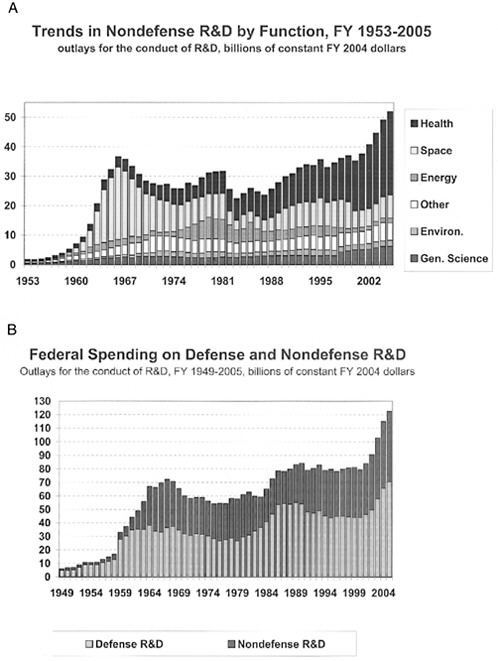
FIGURE 4-32 Trends in (A) nondefense federal research and development and (B) defense plus nondefense federal research and development over the last 50 years. SOURCE: http://www.aaas.org/spp/rd/guihist.htm. Reprinted, with permission, from AAAS (2004). © 2004 by American Association for the Advancement of Science.
TABLE 4-6 Overlap Between the 43 Research Areas in NRC (2001) and the FCCSET Subcategories
|
Research Area from Envisioning the Agenda for Water Resources Research in the Twenty-first Century |
FCCSET Category |
|
Water Availability |
|
|
|
III-A,B,C; IV-B; less III-D,E,F |
|
|
III-A,B,C; IV-B; V-D,F |
|
|
V-D |
|
|
V-G |
|
|
V-B |
|
|
IV-A,D; V-G; VI-F |
|
|
II-J; IV-C; V-C |
|
|
V-C |
|
|
XI-A; less V-C |
|
|
VIII-J; less V-F |
|
|
V-H for humans; |
|
|
VII-B |
|
|
VII-B; II-A; V-A |
|
|
VII-B; less VII-A |
|
|
II-A |
|
|
II-B,E |
|
|
II-B |
|
|
II-M |
|
Water Use |
|
|
|
VI-D |
|
|
III-F |
|
|
III-D,E,F |
|
Research Area from Envisioning the Agenda for Water Resources Research in the Twenty-first Century |
FCCSET Category |
|
|
III-F |
|
|
III-F |
|
|
XI-A |
|
|
XI-A,B |
|
|
XI-A |
|
|
XI-A; less IV-A |
|
Water Institutions |
|
|
|
VI-E |
|
|
VI-E |
|
|
VI-E |
|
|
VI-E |
|
|
VI-E |
|
|
VI-I |
|
|
VI-C |
|
|
VI-C |
|
|
VI-C |
|
|
VI-C |
|
|
VI-C |
|
|
VI-G |
|
|
VI-E |
|
|
VI-H |
|
|
VI-H |
|
|
VI-I; less VI-B |
Severely Underfunded Research Areas
Several things are immediately obvious from Table 4-6. First, there are many research areas (#28–43) that fall primarily under the heading “water institutions” and are part of Category VI—which, as shown in Figures 4-6 and 4-7, receives a small and declining proportion of the water resources research budget. That is, 100 percent of the “water institution” topics are underfunded. The NRC (2001) report argues vigorously for the need to support research in legal, economic, social, and other less technical areas given the complexity of water resources problems likely to characterize the beginning of the new century. The lack of investment in institutional research is readily explainable. Critical reviews of institutional arrangements and the development of innovative institutions do not fit squarely into the missions of any of the existing agencies that conduct and sponsor water resources research. Inasmuch as institutional research is clearly not a priority with these agencies, they hire very few personnel with institutional expertise and therefore have little capacity to accomplish institutional research. The USGS, for example, has only one economist. Moreover, the agencies involved in water resources research are themselves part of the institutional landscape, and as such they are reluctant to engage in research that might threaten their own standing, mission, or mode of organization. The history of federal agencies is not rife with instances of critical self-examination, and change has come slowly and with difficulty.
There is also an unfortunate tendency among policy makers to believe that institutional research infringes on their policy-making authorities, with the consequence that institutional research tends not to be supported. This is unfortunate because it arises from a general failure to understand that institutional research does not a priori entail the making of policy. Rather, like other scientific research, one of its purposes is to inform the making of policy. As a result, it is rare that any federal agency sees any advantage or incentive to support research on institutions, resulting in very minimal investment and a corresponding lack of innovation and change in the institutional arena. Indeed, the country continues to struggle with water laws and institutions devised to address the problems of the 18th and 19th centuries. It will become increasingly difficult to manage water scarcity and deteriorating water quality (see Chapter 1) with institutions that were designed for other purposes.
Similarly, better understanding of water use in various sectors of the economy (#19) is also felt to be of critical importance to solving future water conflicts. Unfortunately, research on water demand has been ignored, largely because no federal agency has a history of doing demand management. Rather, the focus at the federal agencies has been on water supply. Furthermore, there is little incentive for water suppliers to reduce demand, especially if this cuts into revenues needed to cover costs.
All these research priorities (#19, #28–43), while generally supported in the 1960s during a period of overall growth in funding for water issues, receive only 1.5 percent of the current water budget (see Category VI in Figure 4-8B). Furthermore, this is likely an overestimate of the funding in these particular research areas, since the modified FCCSET categories are significantly broader than the 43 research areas.
To a lesser extent, the same can be said of research topics #20–23 in Table 4-6, which deal with making all sectors, but particularly agriculture, more water efficient. Research in Category III has declined since its height in the late 1960s, when desalination research made up the bulk of the investment in water supply augmentation and conservation issues. Similarly, every subcategory of III, including conservation in domestic and municipal, industrial, and agricultural water use, has declined in real terms since the 1960s. This fact also suggests highly inadequate funding for research areas #1 and 2 in Table 4-6, which concern the creation of water supply-enhancing technologies. These trends are unlikely to change in the near future. Agricultural water users are unlikely to support research that could lead to reductions in the allocations of water that they receive. Despite the national trend away from supply augmentation as a means of resolving water scarcity, agricultural users are for the most part wedded to the notion of protecting existing supplies and augmenting supply as a general strategy for managing scarcity. The federal government has not invested extensively in research on supply-enhancing technology, preferring to leave such investment to the private sector where returns can be fully captured. Thus, for example, the vast majority of investment in desalting and water treatment and purification technologies is in the private sector.
Two other research priorities from Table 4-6 are clearly in need of greater support if future water supply problems are to be averted. First, topic #10 suggests that many of our current drinking water systems are nearing the end of their usable lifetimes, requiring research into their rehabilitation and replacement. As shown in Figure 4-7H, around $3 million annually was devoted to this research topic (subcategory VIII-J) in FY1999–2001, which ranges from only 6 percent to 9 percent of the total budget of Category VIII. (This subcategory was not included in the earlier FCCSET survey, preventing a trends analysis). Research areas #12–14, which deal with hydrologic measurement needs, are encompassed by subcategories VII-A and VII-B, and are also underfunded relative to their importance in solving future water resources problems. As shown in Figure 4-7G, funding for research on new methods for hydrologic data acquisition has fallen by 75 percent since the mid 1970s, while funds for network design have been cut by two-thirds in the same time period.
On the basis of these analyses, it is concluded that more than half of the 43 water resources research priorities noted in Chapter 3 are currently grossly underfunded. A continuation of past funding trends will result in substantial underinvestment in a majority of the areas that have been identified as high-
priority areas for the future. Clearly, the patterns of future investment in water resources research will have to be rebalanced if future priorities are to be addressed adequately.
Better Funded Research Areas
Research priorities #3–8, #11, and #15–18 in Table 4-6 fall into FCCSET Categories II (water cycle) and V (water quality) and would appear to be receiving more appropriate absolute levels of funding relative to their importance. Indeed, Categories II and V received a combined 50 percent of all water resources research funding in FY2000, and almost all of the subcategories that overlap with these research priorities are among the best funded in their major category. It should be noted, however, that whether the specific projects noted in Table 4-6 (such as #15—forecasting the hydrologic water cycle over a range of time scales and on a regional basis) are being funded is unclear given the broad nature of some of the subcategories. The need to rebalance the pattern of investment mentioned in the section above suggests that total water resources research funding levels should increase if the absolute level of funding for Categories II and V is to be maintained.
Funding for Category XI, the protection and management of aquatic ecosystems, makes up nearly one-fourth of total water-related FY2000 research expenditures, providing confidence that research areas #9 and #24–27 are receiving support. In general, one way to evaluate the funding for Category XI is to consider the societal risks and potential costs associated with the problems researched. Conflicts between human and environmental uses of water are increasingly costly—the estimated price tags for restoration of the Everglades and the San Francisco Bay Delta (in the $10 billion range over perhaps 20 years) easily top the list, but less costly conflicts appear virtually everywhere and not just in the arid and semiarid West. Future climate change and altered biogeochemical cycles further threaten the health of aquatic ecosystems, and as long as society values healthy, functioning ecosystems and the goods and services they provide, the costs of managing and restoring aquatic ecosystems will be heavy. In this light the current research expenditures appear appropriate. Moreover, the estimated value of healthy ecosystems in providing clean water is rarely precisely known, but in the well-publicized case of New York City’s water supply, $300 million invested in ecosystem protection via riparian land acquisition and other activities may save several billion dollars that otherwise would be needed for water purification infrastructure.
A second line of support for continued funding of Category XI comes from the agency liaisons, who were asked to identify the major water issues confronting the nation in the next five to ten years, irrespective of their agency’s mission. The perspectives of the USGS, NSF, and EPA are particularly germane, as these agencies provide 80 percent of the funding for Category XI and over half of total
water-related research spending. Three of the four topics identified by USGS would fall under Category XI (how to manage a river to restore or protect habitat, understanding global cycles, and evaluating water resource sustainability for ecological and withdrawal use). NSF identified a wide range of fundamental issues, including holistic watershed analysis and enhanced understanding of aquatic ecosystems. EPA’s strategic plan for water resources research includes a portfolio of research focused on human and environmental health.
Budget expenditures within the four XI subcategories indicate distinct agency emphasis on and a preponderance of funding for ecosystem fundamentals and assessment. Support of research into biogeochemical cycles should perhaps be considered for augmentation, and research into the ecological consequences of climate change for freshwater systems currently receives less funding than do other subcategories of XI. The observed dramatic increase in funding for aquatic ecosystem protection and management appears to reflect a societal desire to maintain healthy aquatic ecosystems. This of course in no way negates the importance of safe drinking water or adequate supplies for agriculture, but it does indicate a recognition within funding agencies that society is willing to support the high costs of current efforts to minimize harm to aquatic ecosystems and provide for their repair.
Lower-Priority Research Areas
Finally, there are obviously many subcategories of water resources research that are funded by the federal agencies but are not mentioned in Table 4-6 as being priorities. These include almost all of the subcategories in Categories I (nature of water), VIII (engineering works), IX (manpower, grants, and facilities), and X (scientific and technical information). These make up only 14.5 percent of the total water resources research budget. Categories VIII, IX, and X in particular support continued operations of water resources infrastructure, education, and information dissemination—activities that would not have been noted in NRC (2001) as research priorities given the report’s topical focus. These subcategories’ absence in Table 4-6 should not be interpreted as a suggestion for further reducing their funding.
Appropriate Mix
Assessment of the nation’s portfolio in water-related research requires examining existing funding according to multiple and complex criteria. First, as discussed in Chapter 3, this should be partly based on the balance between research that is long-term vs. short-term, fundamental vs. applied, investigator-driven vs. mission-driven, and internal (agency scientists) vs. external (universities, contractors). Furthermore, NRC (2001) identified 43 research priorities within three categories—water availability, water use, and water institutions—and stressed
the importance of addressing these three broad areas. Lastly, research activities that incorporate one or more of the four themes presented in Chapter 3 (interdisciplinarity, broad systems context, uncertainty, and the importance of human and ecosystem adaptation) are likely to be most effective in providing solutions to society’s most critical water-related problems (see Chapter 1).
Short-term vs. Long-term Research
The terms “long-term vs. short-term,” “fundamental vs. applied,” “investigator-driven vs. mission-driven,” and “internal vs. external” are defined in Box 3-1, which suggests that there are often positive correlations between research that is longer-term, more fundamental, investigator-driven, and externally conducted. Thus, the following analysis does not separately address each of these characteristics, but rather tries to make generalizations based on information from the federal agency liaisons about whether their research programs are short- or long-term and about how much research is conducted internally vs. externally (see Table 4-4).
It is tempting to try to determine the percentage of the total water resources research budget that goes toward long-term vs. short-term research by considering the nature of the individual modified FCCSET categories. Unfortunately, several of the largest categories include research that falls along the entire spectrum from short- to long-term and that addresses poorly understood phenomena or processes that are relevant to applied water issues but require new knowledge. Category II (water cycle) exemplifies research where a basic understanding of processes such as evapotranspiration and runoff is critical to management of a water supply, and where changing land use and climate add new complexities. Category V (water quality management and protection) likewise involves new understanding of contaminant transport, fate, and effect, and draws significant support from NSF and USGS as well as EPA. Categories VI (planning) and VII (resources data), both small slices of the overall funding, are supported by a diversity of agencies. Category XI includes research that is relatively long-term and applied, such as studies of aquatic habitat and the development of assessment methods; it also includes knowledge-generating research motivated by the need for aquatic ecosystem protection and management.
Several other categories clearly are primarily applied and require answers in the shortest practical time frame. Category III (water supply augmentation and conservation), funded primarily by USDA and USBR, is concerned with water supplies for agriculture, urban consumption, and power generation. Category IV (water quantity management and control), dominated by USDA followed by EPA and DoD, emphasizes practical applications to, for example, agricultural watershed management and control of polluted runoff. Category VIII (engineering works) is funded almost entirely by the Corps. Research in these three categories is usually carried out internally or through highly targeted contracts and grants.
Together these categories make up 17 percent of total water resources research expenditures.
Long-term, basic research predominates in few categories. Research into Category I (nature of water) is very fundamental, receives minimal funding (almost exclusively from NSF), and arguably is not an urgent priority. Some elements of Category XI, particularly NSF and USGS support of climate and biogeochemical research, should be considered fundamental research. In these categories, research can be characterized as primarily long-term and basic, and it appears likely that half or more occurs at universities and other research institutions. Despite all these inferences, it is difficult to conclude that a certain percentage of water resources research is short-term vs. long-term based on the modified FCCSET categories alone.
A different approach relies on information provided by the five largest contributing federal agencies regarding the percentage of their funding that is long-term and basic vs. short-term and applied. NSF, USGS, EPA, DoD, and USDA contributed 88 percent of the federal water resources research budget in 2000. The information they provided about the percentage of their research that is short-term vs. long-term and internal vs. extramural (Table 4-4) suggests that at least one-fourth but less than one-half of water resources research reported by the federal agencies can be classified as research of a more basic and long-term nature, likely taking place at universities and nonfederal research institutions. In the view of the committee, between one-third and one-half of the total water resources research portfolio should be allocated to longer-term, more fundamental, investigator-driven research to ensure that critical knowledge will be available on which to base water resources management in the next 10–15 years. Given the current balance, this seems highly achievable with a relatively minor change in emphasis. Considering the emerging problems of contaminants and pathogens that occur at low concentrations, the challenge of reconciling the water demands of humans and ecosystems, the uncertainties associated with climate change and human alteration of biogeochemical cycles, and the pending exhaustion of surface water supplies, there is reason for concern about whether the existing portfolio can provide the needed critical knowledge.
There are several reasons why not enough of the current research portfolio is focused on long-term and fundamental research. OMB examiners explained to committee members that they are often not inclined to support long-term and fundamental research because it does not have immediately usable or useful results and it is hard to judge its effectiveness. Furthermore, the structure of incentives to the agencies tends to be linked to the time scales of elected officials, with the result that there is little emphasis on long-term research. OMB typically supports this outcome by requiring that agencies stick to their stated missions (which may or may not include long-term goals). It seems apparent then that the structure of incentives at the federal level contains some bias against longer-term research on topics in water resources, which likely permeates the development of
longer-term research agendas within the federal agencies (although there are some exceptions).
While it is true that the desire for institutional commitment, continuity in personnel, and effectiveness of control favors internally conducted research over externally conducted research, the disadvantages of temporal bias and reduced flexibility should be considered. Research needed to adapt to new conditions might be more difficult for an internally focused agency because resources are tied up in maintaining existing research staff, who may not have the necessary expertise in new and innovative fields. The increased involvement of academic scientists through peer-reviewed grants would strengthen the overall water resources research capacity by expanding the pool of researchers, by providing more flexible research capacity, by placing greater emphasis on competitive evaluation of projects in terms of national priorities and quality of research, and by providing avenues through which the bias against longer-term research can be counteracted. (It should be noted that some federal agencies conduct peer review of internally conducted research projects.)
Water Availability, Water Use, and Water Institutions
In terms of whether the research portfolio adequately addresses the three broad areas of water availability, water use, and water institutions outlined in NRC (2001), both water use and water institutions are currently underfunded. For reasons discussed above, almost every research priority listed under water institutions belongs to a modified FCCSET category that has seen declining proportions of the federal water resources research budget since the 1960s. Those research priorities falling under water use have been similarly neglected with the exception of those within Category XI. While it is certainly not appropriate to suggest that each of the three broad areas of water availability, water use, and water institutions should receive one-third of the annual budget, given that the 43 research areas are of varying breadth and complexity, it is clear that the current distribution is out of balance. The committee does not believe it to be unreasonable that 10 percent of the total water resources research budget be allocated to combined water use and institutional topics. Currently, and as discussed in detail in NRC (2001), almost nothing in known about the determinants and extent of public water uses, and very little is known about water use in other sectors. As discussed previously, institutional topics are similarly under-studied.
Interdisciplinarity, Broad Systems Context, Uncertainty, and Adaptation
One of the categories experiencing a severe reduction in research funding from the 1973–1975 levels is Category VI—water resources planning and other institutional issues (see Table 4-2). Ironically, this is the synthesis category that would support research questions with a strong interdisciplinary nature and with
a broad systems context—key themes for the national water resources research agenda proposed in Chapter 3. This is also the category that would best encompass the significant present-day issues of human and ecological adaptation to changing water resources conditions. As argued in Chapter 3, for multiple research agencies to be able to tackle complex emerging water problems in a way that will enhance our understanding beyond an incremental level, the themes of interdisciplinarity, broad systems context, uncertainty, and adaptation must permeate future research in water resources. Although there are a few initiatives that address interdisciplinarity (see Box 4-2 for an example), an increase in research funding for Category VI with specific emphasis on the aforementioned four themes is certainly warranted.
|
BOX 4-2 Federal agencies have markedly increased their emphasis on interdisciplinary research through new program initiatives, including single-agency calls for proposals and multiagency partnerships. Several NSF initiatives provide instructive examples of progress toward integration across disciplines as well as an increased emphasis on synthesis science and complex systems. NSF’s Long-Term Ecological Research (LTER) network is perhaps the longest-running experiment in interdisciplinary ecological research. Now 20 years old and consisting of a network of 24 sites across diverse ecosystems (including two urban sites), the LTER program has brought together ecologists, ecosystem scientists, hydrologists, geochemists, and other specialists and has led to extensive multidisciplinary collaboration directed at understanding ecosystems and their response to human activities. In FY2002 the LTER program had a funding level of $17.8 million and it supported 1,100 scientists and students (NSF, 2002); the next ten years are expected to emphasize “synthesis science” and incorporate social science more than has previously been the case. Most LTER-funded research has addressed scientific questions best described as fundamental and long-term. The Water and Watersheds program, beginning in 1995, funded interdisciplinary projects that synthesized physicochemical, biological, and social science expertise in addressing water and watershed issues. NSF, |
CONCLUSIONS AND RECOMMENDATIONS
Analysis of the survey budget data and narratives shows that the independent research efforts conducted by various federal agencies to respond to funding mandates of the past only partially recognize the emerging water problems of the future. One clear deficiency is the low and declining funding of research related to water institutions and planning, despite the important role of the social sciences in providing knowledge to help meet future demands for water for human and environmental uses. The current national investment in water resources research needs adjustments in its magnitude and mix to meet the challenges that lie ahead.
A quantitative analysis showed that real levels of total spending for water resources research have remained relatively constant (around $700 million
|
EPA, and USDA jointly provided funding over Water and Watersheds’ six years of existence. A number of the funded studies utilized hydrologic models, GIS land-use analysis, and field studies of physical, chemical, and biological response variables to address topics such as nutrient runoff and ecological status and trends. Those familiar with this program generally saw it as successful, although perhaps not in its involvement of social scientists. Furthermore, the program lacked sufficient support within the agencies for its continuation. Most research activities were motivated by applied issues, but required new knowledge and approaches. NSF’s Biocomplexity Initiative, begun in 1999, emphasizes an interdisciplinary, complex systems approach to environmental research in several areas, of which the programs in coupled human and natural systems and coupled biogeochemical cycles are most relevant to water resources research. A recently established NSF Advisory Committee for Environmental Research and Education indicates that support for this initiative may extend for another decade or more, and it has expressed the need for long-term, well-defined programmatic initiatives in order to incorporate interdisciplinary research and address complex environmental questions and problems (NSF, 2002). Biocomplexity in the environment now encompasses a broad spectrum of NSF-funded research and in 2003 received about $30 million in total research awards. Most of the research can be characterized as fundamental in nature, but with well-articulated relevance to environmental concerns. |
in 2000 dollars) since the mid 1970s. When Category XI (aquatic ecosystems) is subtracted from the total funding, there is very high likelihood that the funding level has actually declined over the last 30 years, even under assumptions of significant data uncertainty. In particular, it is almost certain that funds in Categories III (water supply augmentation and conservation), V (water quality management and protection), VI (water resources planning and institutional issues), and VII (resources data) have declined severely since the mid 1970s. Of particular note is the severe reduction in funding for Category VI (water resources planning and institutional issues). Although the historical data and those collected as part of the present survey contain significant uncertainty, this was accounted for using a likelihood framework as described in Appendix C.
Water resources research funding has not paralleled growth in demographic and economic parameters such as population, GDP, or budget outlays (unlike research in other fields such as health). Since 1973, the population of the United States has increased by 26 percent, the GDP and federal budget outlays have more than doubled, and federal funding for all research and development has almost doubled, while funding for water resources research has remained stagnant. This suggests that water resources research has not been accorded priority over the past 30 years. Given that the pressure on water resources varies more or less directly with population and economic growth, and given sharp and intensifying increases in conflicts over water, a new and expanded commitment will have to be made to water resources research if the nation is to be successful in addressing its water and water management problems over the next 10–15 years.
The topical balance of the federal water resources research portfolio has changed since the 1965–1975 period, such that the present balance appears to be inconsistent with current priorities (as outlined in Chapter 3). Research on water demand, water law, and other institutional topics as well as on water supply augmentation and conservation now garners a significantly smaller proportion of the total water research funding than it did 30 years ago. In an absolute sense these categories appear to be significantly underfunded. When the current water resources research enterprise is compared with the list of research priorities for the future, it becomes clear that significant new investment must be made in these categories of research if the national water agenda is to be addressed adequately.
Additional funds should be invested in high-priority topical areas that are currently neglected, including water supply augmentation and conservation, monitoring, and several institutional topics. If enhanced funding to support research in these categories is not diverted from other categories (which may also have priority), the total water resources research budget will have to be enhanced.
The current water resources research portfolio appears heavily weighted in favor of short-term research. This is not surprising in view of the de-emphasis of long-term research in the portfolios of federal agencies. It is important to emphasize that long-term research forms the foundation for short-term research in the future. A mechanism should be developed to ensure that long-term research accounts for one-third to one-half of the portfolio.
OMB should develop guidance to agencies on reporting water resources research by topical categories. Understanding the full and multiple dimensions of the federal investment in water resources research is critical to making judgments about adequacy. In spite of clearly stated OMB definitions of research, agencies report research activity unevenly and inconsistently. In its discussions with federal agency representatives, the committee learned that agencies fund research through multiple budget accounts. Only projects that are specifically funded through research accounts are counted as such and are reported to OMB as research activities. Research funded through operational or “place-based” projects such as the Everglades or the San Francisco Bay Delta is not reported to OMB as research. Failure to fully account for all research activity undermines efforts by the administration and Congress to understand the level and distribution of water resources research. This problem could be remedied if OMB required agencies to report all research activity, regardless of budget account, in a consistent manner.
REFERENCES
American Association for the Advancement of Science (AAAS). 2000, 2001, 2002, 2003. AAAS report XXV, XXVI, XXVII, and XXVIII on Research and Development for FY 2001, 2002, 2003, and 2004. Washington, DC: AAAS Intersociety Working Group.
Committee on Water Resources Research (COWRR). 1973 and 1974. Federal Water Resources Research Program for 1973 and 1974. COWRR, FCCSET. Washington, DC: National Science Foundation.
Committee on Water Resources Research (COWRR). 1977. Directions in U.S. Water Research: 1978–1982. Washington, DC: OSTP Federal Coordination Council for Science, Engineering and Technology (FCCSET).
Department of Energy (DOE). 2002. Yucca Mountain Project: Recommendation by the Secretary of Energy Regarding the Suitability of the Yucca Mountain Site for a Repository under the Nuclear Waste Policy Act of 1982. Washington, DC: Office of Civilian Radioactive Waste Management.
Department of Energy (DOE). 2003. The Department of Energy Strategic Plan. DOE/ME–0030. Washington, DC: DOE.
National Research Council (NRC). 1981. Federal Water Resources Research: A Review of the Proposed Five-Year Program Plan. Washington, DC: National Academy Press.
National Research Council (NRC). 2001. Envisioning the Agenda for Water Resources Research in the Twenty–First Century. Washington, DC: National Academy Press.
National Science Foundation. 2002. Long–Term Ecological Research Program: Twenty–Year Review. Available at http://intranet.lternet.edu/archives/documents/reports/20_yr_review/#1.0.
U.S. General Accounting Office (GAO). 2001. Water Infrastructure: Information on Federal and State Financial Assistance. GAO 02–134. Washington, DC: GAO.
U.S. General Accounting Office (GAO). 2002. Water Infrastructure: Information on Financing, Capital Planning, and Privatization. GAO 02–764. Washington, DC: GAO.
U.S. Geological Survey (USGS). 2002. U.S. Geological Survey Strategic Plan FY2000–2005. Washington, DC: Department of the Interior. http://www.usgs.gov/stratplan/stratplan_rev.pdf.
U.S. Geological Survey (USGS). 2004. Mission of the Water Resources Discipline. Washington, DC: Department of the Interior. http://water.usgs.gov/welcome.html.
U.S. Government Printing Office. 2003. The Budget for Fiscal Year 2004, Historical Tables. Washington, DC.

